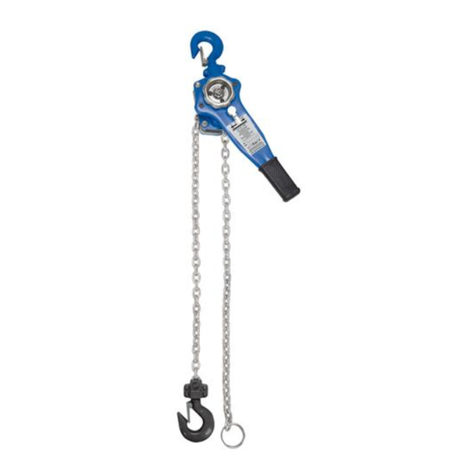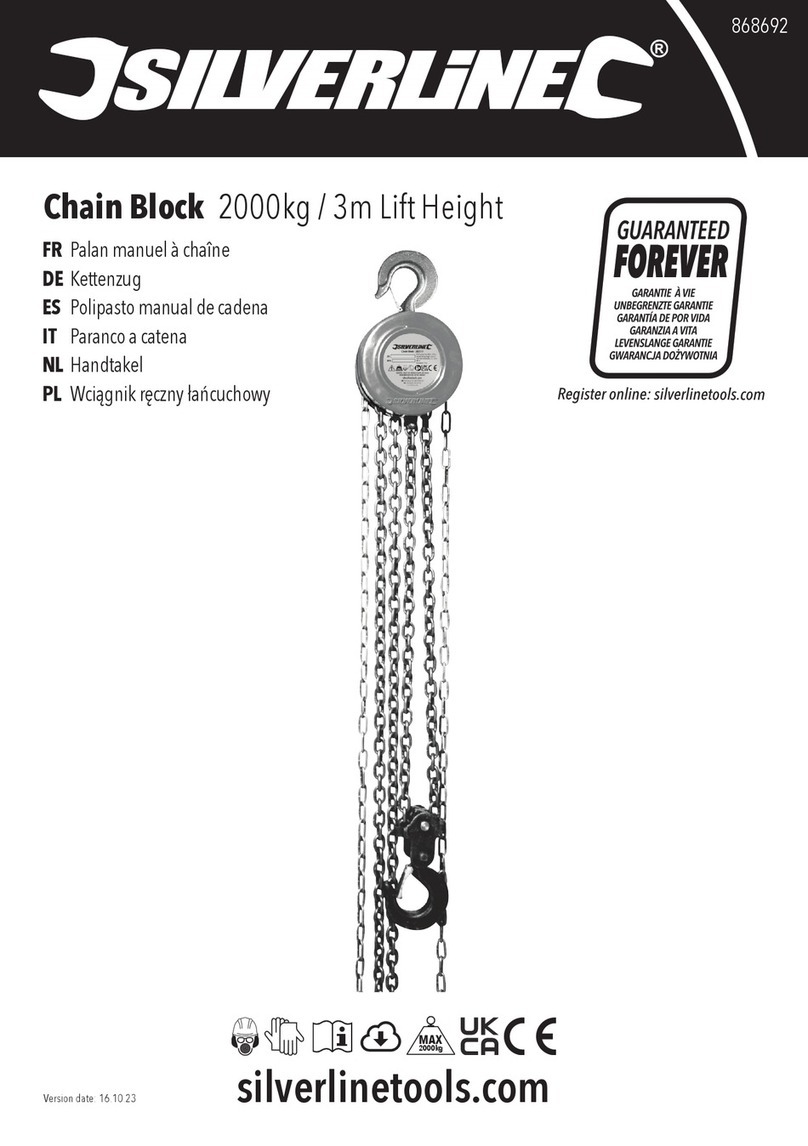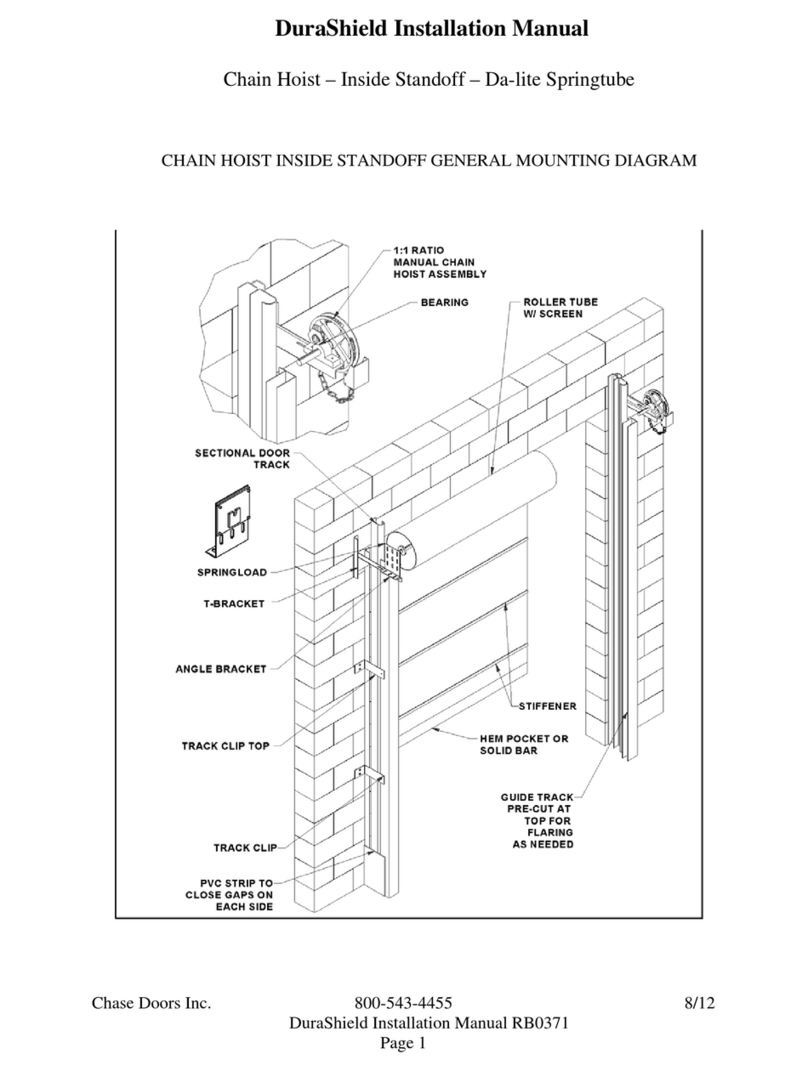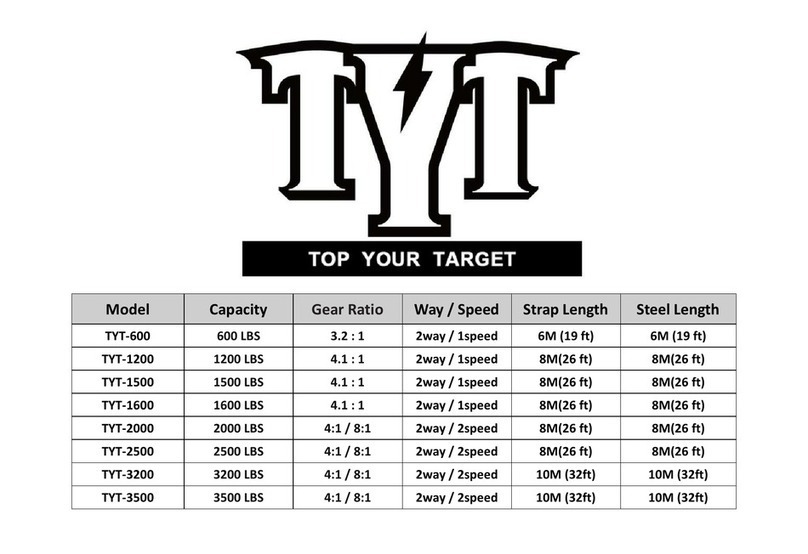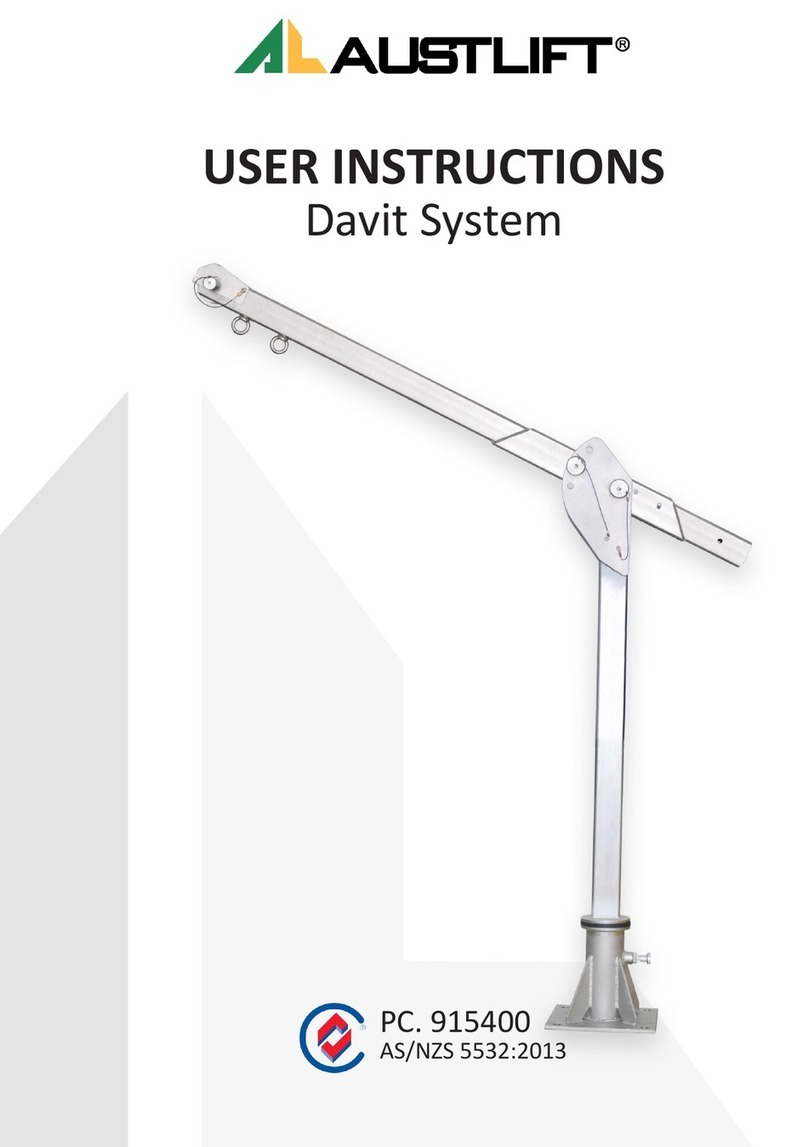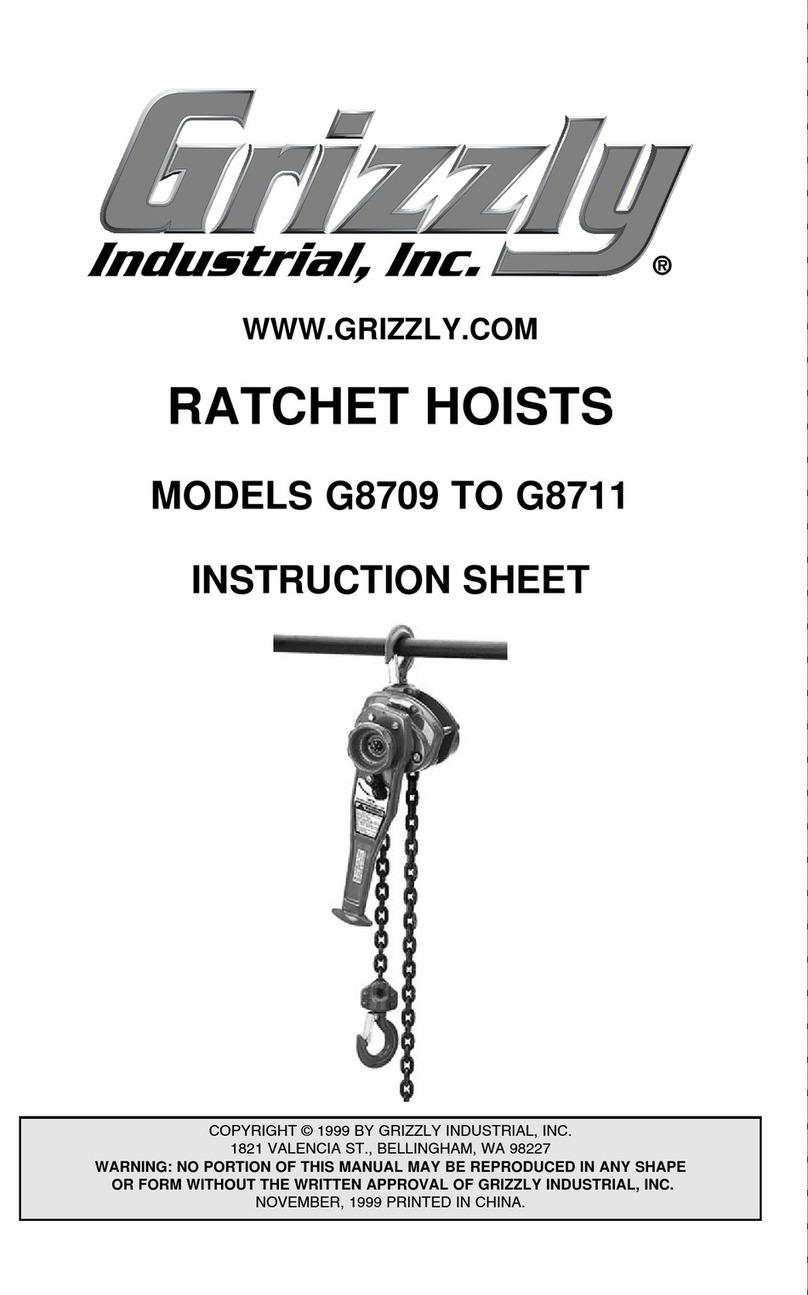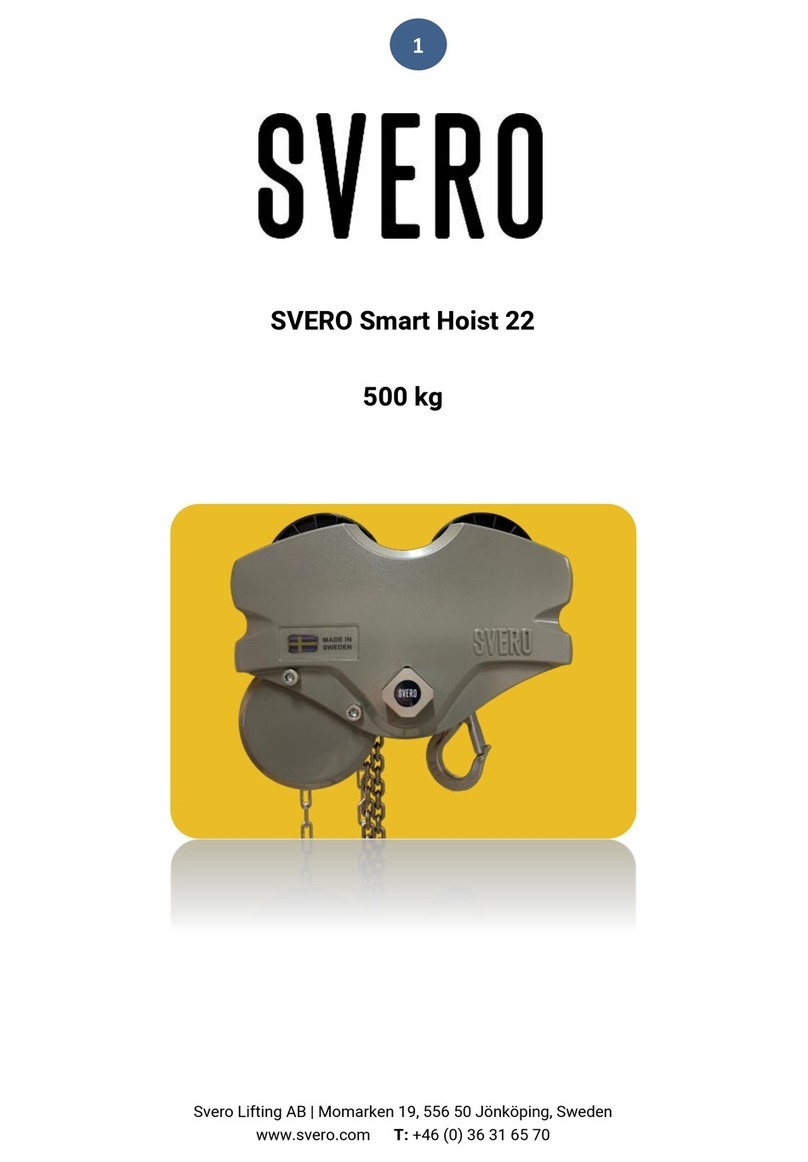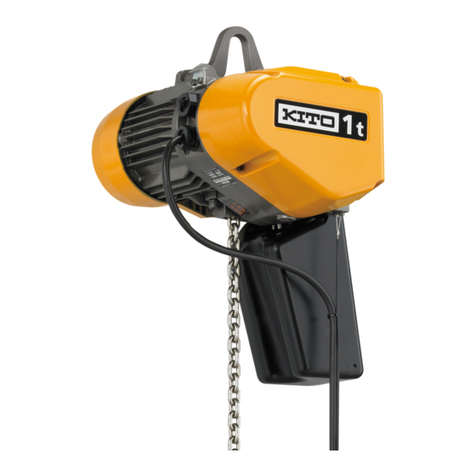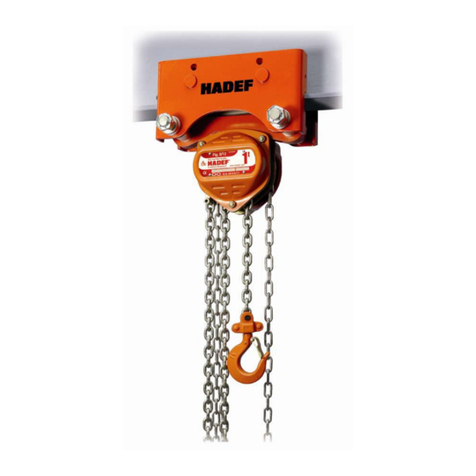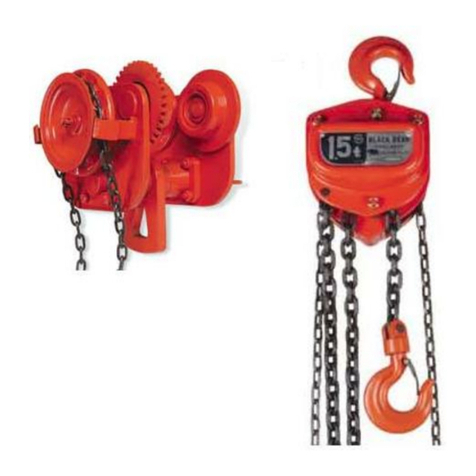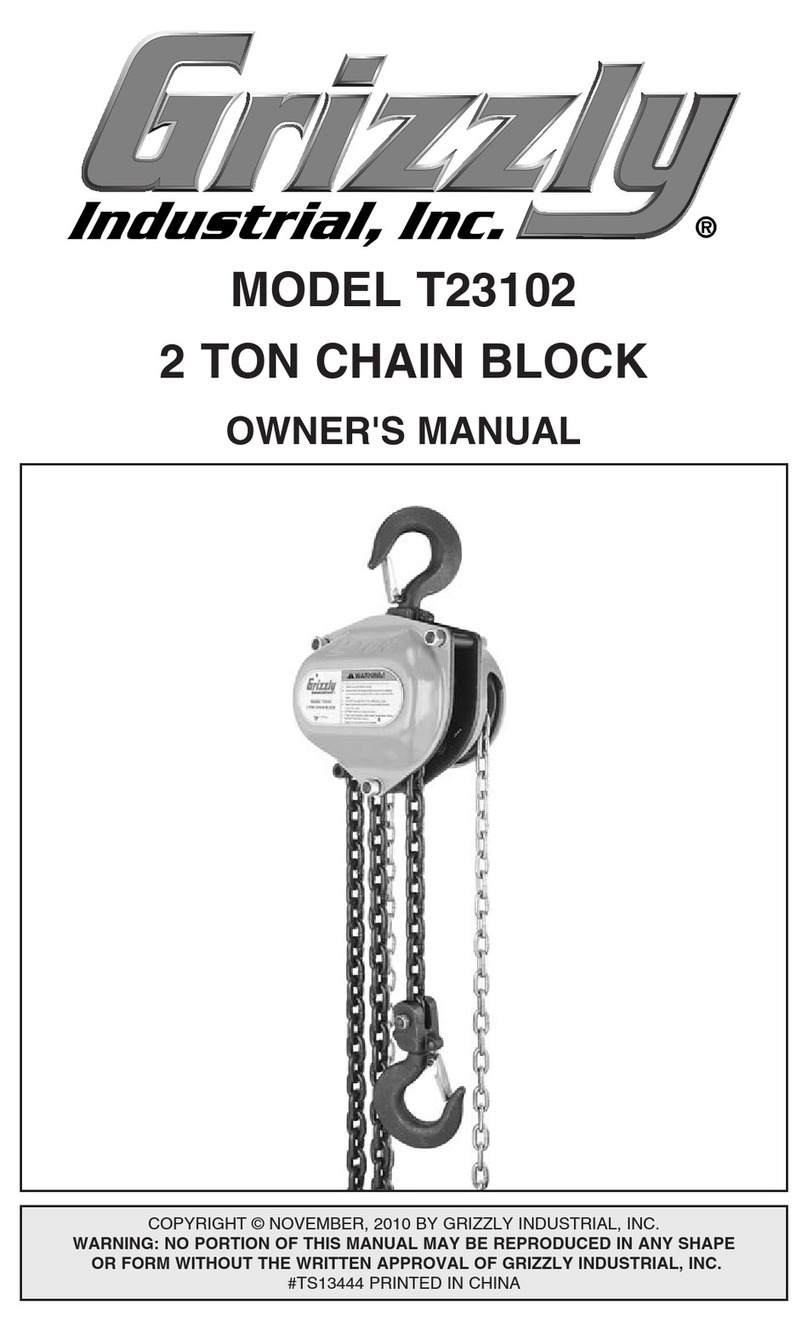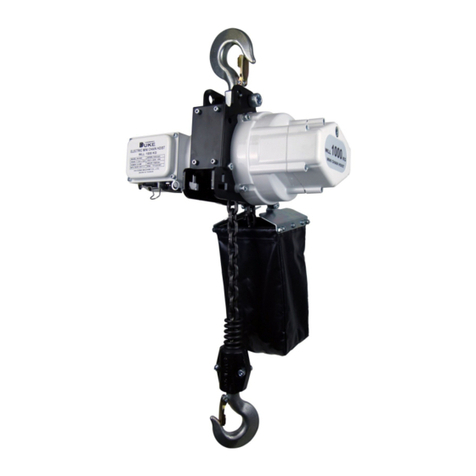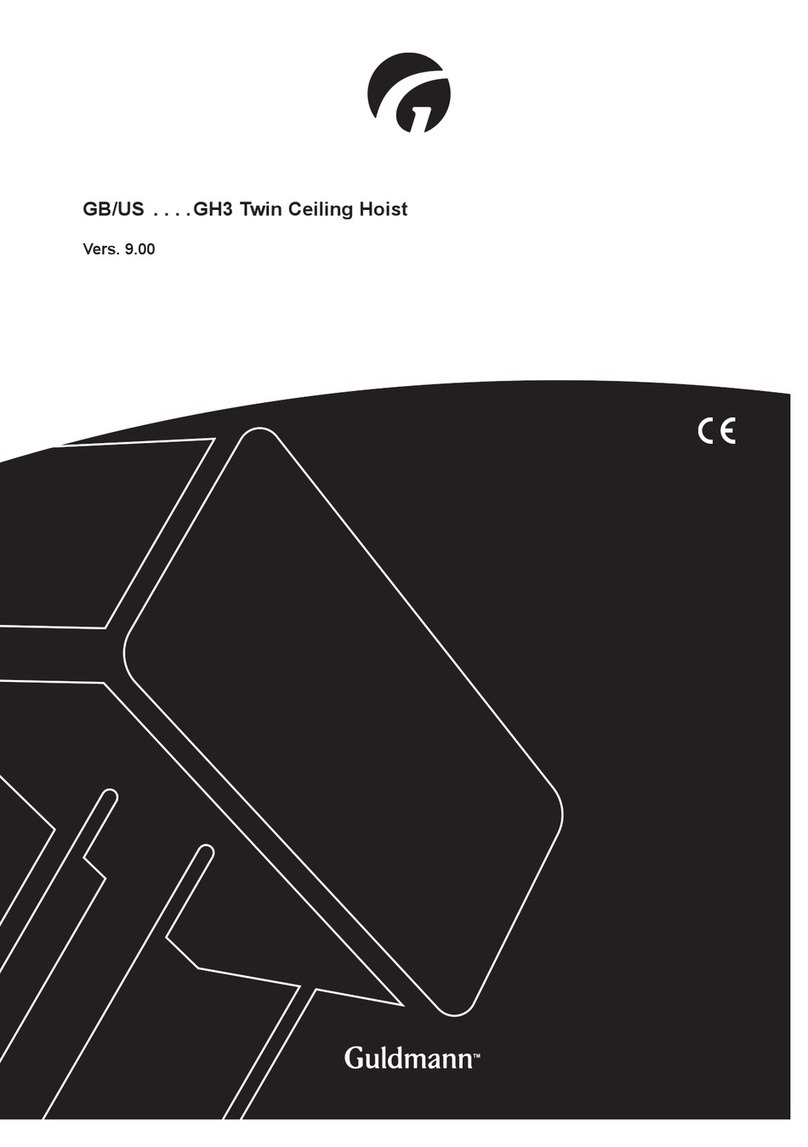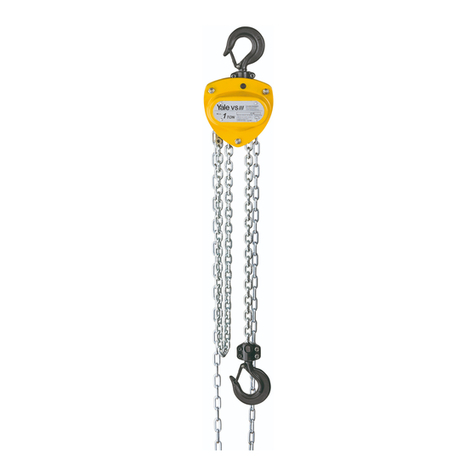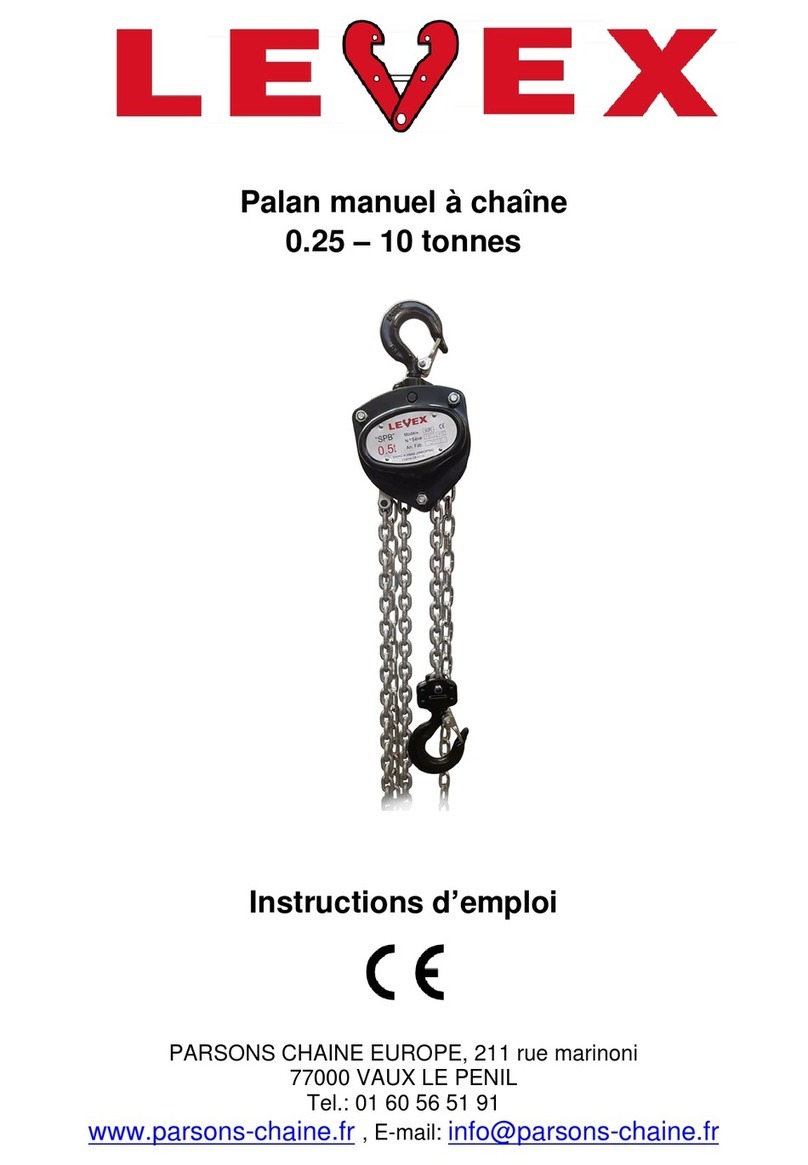Silverline 442463 User manual

www.silverlinetools.com
442463
900W Electric Hoist
Palan électrique 900 W
Elektroseilzug, 900 W
900W Electric Hoist
Polipasto eléctrico 900 W
Paranco elettrico 900 W
900 W elektrische takel
500kg
Version date: 06.12.16
442463_Z1MANPRO1.indd 2 06/12/2016 12:33

22
1
2
3
4
5
6
7
8
10 11
9
1213141516
442463_Z1MANPRO1.indd 2 06/12/2016 12:33

www.silverlinetools.com 3
English .................. 4
Français ................ 10
Deutsch................. 16
Español ................. 22
Italiano .................. 28
Nederlands............ 34
www.silverlinetools.com 3
263040
900W Electric Hoist
500kg
442463_Z1MANPRO1.indd 3 06/12/2016 12:33

4
GB Original Instructions
WARNING: Always wear ear protection where the sound level exceeds
85dB(A) and limit the time of exposure if necessary. If sound levels are
uncomfortable, even with ear protection, stop using the tool immediately
and check the ear protection is correctly fitted and provides the correct level
of sound attenuation for the level of sound produced by your tool.
WARNING: User exposure to tool vibration can result in loss of sense of
touch, numbness, tingling and reduced ability to grip. Long term exposure
can lead to a chronic condition. If necessary, limit the length of time
exposed to vibration and use anti-vibration gloves. Do not operate the tool
with hands below a normal comfortable temperature, as vibration will have
a greater effect. Use the figures provided in the specification relating to
vibration to calculate the duration and frequency of operating the tool.
Sound and vibration levels in the specification are determined according
to EN60745 or similar international standards. The figures represent
normal use for the tool in normal working conditions. A poorly maintained,
incorrectly assembled, or misused tool, may produce increased levels of
noise and vibration. www.osha.europa.eu provides information on sound
and vibration levels in the workplace that may be useful to domestic users
who use tools for long periods of time.
Description of Symbols
The rating plate on your tool may show symbols. These represent important
information about the product or instructions on its use.
Wear hearing protection
Wear eye protection
Wear breathing protection
Wear head protection
Wear hand protection
Read instruction manual
Class I construction (protective earth)
DO NOT use in rain or damp environments!
Maximum load
For indoors use only!
Environmental Protection
Waste electrical products should not be disposed of with
household waste. Please recycle where facilities exist. Check
with your local authority or retailer for recycling advice.
Conforms to relevant legislation and safety standards.
Caution!
WARNING
LIFTING HAZARD
Single Person Lift could cause injury
Use assistance when moving or lifting
WARNING:This product is heavy and as a precaution it is
advised that two people assemble the machine.
VVolts
~Alternating current
AAmpere
nRated speed
Hz Hertz
W, kW Watt, kilowatt
/min or min-1 (revolutions or reciprocation) per minute
Technical Abbreviations Key
MAX
150kg
T-130˚
Specification
Voltage:...........................................................230-240V~ 50Hz
Power: ............................................................................. 900W
Maximum lifting capacity: ................... 500kg with return pulley
250kg without return pulley
Maximum lifting height:............................6m with return pulley
12m without return pulley
Average lifting speed:........................0.6 m/s with return pulley
1.3 m/s without return pulley
Ingress protection:.............................................................. IP54
Protection class: ........................................................................
Weight: ........................................................................... 16.5kg
The sound intensity level for the operator may exceed 85dB(A) and
sound protection measures are necessary.
As part of our ongoing product development, specifications of Silverline
products may alter without notice.
Introduction
Thank you for purchasing this Silverline tool. This manual contains information
necessary for safe and effective operation of this product. This product has
unique features and, even if you are familiar with similar products, it is necessary
to read this manual carefully to ensure you fully understand the instructions.
Ensure all users of the tool read and fully understand this manual.
442463_Z1MANPRO1.indd 4 06/12/2016 12:33

www.silverlinetools.com 5
900W Electric Hoist442463
General Power Tool Safety Warnings
WARNING! When using electric power tools, basic safety precautions
should always be followed to reduce the risk of fire, electric shock and
personal injury including the following safety information. Read all these
instructions before attempting to operate this product and save these
instructions for future use.
WARNING:This appliance is not intended for use by persons (including
children) with reduced, physical or mental capabilities or lack of experience
or knowledge unless they have been given supervision or instruction
concerning use of the appliance by a person responsible for their safety.
Children must be supervised to ensure that they do not play with the
appliance.
CAUTION: Use the power tool, accessories and tool bits etc. in accordance
with these instructions, taking into account the working conditions and the
work to be performed. Use of the power tool for operations different from
those intended could result in a hazardous situation.
The term "power tool" in the warnings refers to your mains-operated
(corded) power tool or battery-operated (cordless) power tool.
1 - Keep work area clear - Cluttered areas and benches invite injuries
2 - Consider work area environment
- Do not expose tools to rain
- Do not use tools in damp or wet locations
- Keep work area well lit
- Do not use tools in the presence of flammable liquids or gases
3 - Guard against electric shock - Avoid body contact with earthed or
grounded surfaces (e.g. pipes, radiators, ranges, refrigerators)
4 - Keep other persons away - Do not let persons, especially children,
not involved in the work touch the tool or the extension cord and keep
them away from the work area
5 - Store idle tools - When not in use, tools should be stored in a dry
locked-up place, out of reach of children
6 - Do not force the tool - It will perform the job better and safer at the
rate for which it was intended
7 - Use the right tool - Do not force small tools to do the job of a heavy
duty tool
- Do not use tools for purposes for which they are not intended; for
example do not use circular saws to cut tree limbs or logs
8 - Dress appropriately
- Do not wear loose clothing or jewellery, which can be caught in
moving parts
- Suitable safety footwear is recommended when working outdoors.
- Wear protective covering to contain long hair
9 - Use protective equipment
-Use safety glasses
-Use face or dust mask if working operations create dust
WARNING: Not using protective equipment or appropriate clothing can
cause personal injury or increase the severity of an injury.
10 - Connect dust extraction equipment - If the tool is provided for the
connection of dust extraction and collecting equipment, ensure these
are connected and properly used
11 - Do not abuse the power cable - Never pull the power cable to
disconnect it from the socket. Keep the power cable away from heat, oil
and sharp edges. Damaged or entangled power cables increase the risk
of electric shock
12 - Secure work - Where possible use clamps or a vice to hold the work.
It is safer than using your hands
13 - Do not overreach - Keep proper footing and balance at all times
14 - Maintain tools with care
- Keeping cutting tools sharp and clean makes the tool easier to control
and less likely to bind or lock in the workpiece
- Follow instructions for lubricating and changing accessories
- Inspect tool power cables periodically and have them repaired by an
authorised service facility if damaged
- Inspect extension cables periodically and replace if damaged
- Keep handles dry, clean and free from oil and grease
WARNING: Many accidents are caused by poorly maintained power tools.
15 - Disconnect tools - Disconnect tools from the power supply when not
in use, before servicing and when changing accessories such as blades,
bits and cutters
WARNING:The use of accessories or attachments not recommended by the
manufacturer may result in a risk of injury to persons.
16 - Remove adjusting keys and wrenches - Form the habit of checking
to see that keys and adjusting wrenches are removed from the tool
before switching it on
17 - Avoid unintentional starting - Ensure switch is in “off” position
when connecting to a mains socket, inserting a battery pack, or when
picking up or carrying the tool
WARNING: Unintended starting of a tool can cause major injuries.
18 - Use outdoor extension leads - When the tool is used outdoors, use
only extension cords intended for outdoor use and so marked. Use of
an extension cable suitable for outdoor use reduces the risk of electric
shock
19 - Stay alert
- Watch what you are doing, use common sense and do not operate the
tool when you are tired
- Do not use a power tool while you are under the influence of drugs,
alcohol or medication
WARNING:A moment of inattention while operating power tools may result
in serious personal injury.
20 - Check damaged parts
- Before further use of tool, it should be carefully checked to determine
that it will operate properly and perform its intended function
- Check for alignment of moving parts, binding of moving parts,
breakage of parts, mounting and any other conditions that may affect its
operation
- A guard or other part that is damaged should be properly repaired or
replaced by an authorised service centre unless otherwise indicated in
this instruction manual
- Have defective switches replaced by an authorised service centre
WARNING: Do not use the tool if the on/off switch does not switch it on and
off. The switch must be repaired before the tool is used.
21 - Have your tool repaired by a qualified person - This electric tool
complies with the relevant safety rules. Repairs should only be carried
out by qualified persons, otherwise this may result in considerable
danger to the user
WARNING:When servicing use only identical replacement parts.
WARNING: If the power cable is damaged it must be replaced by the
manufacturer or an authorised service centre.
22 - Power tool mains plugs must match the mains socket - Never
modify the plug in any way. Do not use any adapter plugs with earthed
(grounded) power tools. Unmodified plugs and matching sockets will
reduce risk of electric shock
23 - If operating a power tool outside use a residual current device (RCD) -
Use of an RCD reduces the risk of electric shock
NOTE:The term “residual current device (RCD)” may be replaced by the
term “ground fault circuit interrupter (GFCI)” or “earth leakage circuit
breaker (ELCB)”.
WARNING:When used in Australia or New Zealand, it is recommended that
this tool is ALWAYS supplied via Residual Current Device (RCD) with a rated
residual current of 30mA or less.
WARNING: Before connecting a tool to a power source (mains switch power
point receptacle, outlet, etc.) be sure that the voltage supply is the same as
that specified on the nameplate of the tool. A power source with a voltage
greater than that specified for the tool can result in serious injury to the
user and damage to the tool. If in doubt, do not plug in the tool. Using a
power source with a voltage less than the nameplate rating is harmful to
the motor.
442463_Z1MANPRO1.indd 5 06/12/2016 12:33

66
GB
Polarised Plugs (for North America only) To reduce the risk of electric shock,
this equipment has a polarized plug (one blade is wider than the other).
This plug will fit in a polarized outlet only one way. If the plug does not fit
fully in the outlet, reverse the plug. If it still does not fit, contact a qualified
electrician to install the proper outlet. Do not change the plug in any way.
Electric Hoist Safety Instructions
• Before each use; inspect the steel cable for imperfections and
weaknesses. Do not use if the cable is frayed, kinked or wrapped
improperly around the reel. If the cable requires replacing do not replace
with a cable of lesser strength. Always leave at least three turns of the
cable on the spool to ensure that the hoist is able to lift the stated weight
capacity
• Inspect the operator’s controller before attempting to use the hoist. Do
not use if the controller is damaged. Avoid operating the hoist in damp
or wet conditions
• Stand clear of any item being lifted by the hoist or underneath any item
being suspended by the hoist
• Do not hold the steel cable while lifting or lowering any item
• Never operate this tool alone, always have an extra person to help guide
the object being lifted
• Observe the maximum capacities and height limitations mentioned in the
specifications. Never exceed the figures
• Ensure the hoist is mounted to a beam which has a maximum capacity
which is double the capacity of the hoist. The beam should be at least
43mm in diameter and have a wall thickness of at least 3mm
• The hoist is not designed for continuous use and the motor has an in-
built thermostat to prevent overheating and overloading. If the thermostat
is activated, the ‘cool down’ period will be approximately 5 minutes. If the
motor is exposed to direct sunlight it will severely reduce its operating
time before the thermostat will activate the ‘cool down’ period
• The electric hoist is fitted with an automatic shut off when it has reached
its highest point and lowest point. The height limiter is activated when the
Stop Block reaches the Up Limit Lever.The lowering limiter is activated
when the cable reaches the lowest possible point and the cable is still
safe to hold the maximum load, the cable then engages with the Down
Limit Lever.
• Always ensure that the unit is wound as shown:
• Never lift people or animals using this hoist. When operating the hoist
always keep bystanders and animals away from the load.
Cargo Sling Safety
Safe use of textile safety equipment
• All cargo slings should be inspected before use by a competent person
• Before using the cargo sling ensure that the rating is suitable for the
intended task
• The selected cargo sling should be both strong enough and of the correct
length for the mode of use
• Secure the load carefully, taking into account the size of the load and the
height being lifted
• Where two or more cargo slings are used to secure a load, they should
be identical, preferably from the same batch
• Cargo slings should be protected against friction, sharp edges or any
surface likely to cause damage
NOTE: Cargo slings should never be pulled from under loads.
• Never knot or twist a cargo sling beyond that of a choker lift
• Avoid snatch or shock loading as the WLL can easily be exceeded in such
circumstances
• Avoid contact with heat and hot surfaces
• Never trap a cargo sling under a load; crushing can seriously damage
a cargo sling
• Do not use slings to transport people or allow people to pass under a
suspended load
• On completion of the lifting operation, return the cargo sling to secure
storage
• Prior to placing in storage, inspect the cargo sling for any damage which
may have occurred during use
• Cargo slings which have become wet in use or as a result of cleaning
should be hung up and allowed to dry naturally
• Cargo slings should be stored at room temperature in clean, dry, and
well-ventilated conditions
• Do not store or use cargo slings for extended periods in direct sunlight or
sources of UV radiation
• Never attempt to repair cargo slings; dispose of immediately if damaged
or visibly worn
• A cargo sling that has a missing or unreadable label and is unidentifiable
should be disposed of
• Checks should also include any fittings and lifting accessories used in
association with the cargo sling
• Heat or friction damage is indicated by the fibres taking on a glazed
appearance; in extreme cases, fusion of the fibres can occur. If this is
visible the cargo sling should be removed from service
• At very low temperatures, when moisture is present, ice can form
within the sling and there is a risk the ice will act as a cutting agent and
damage the sling fibres
• All cargo slings should be part of a regular examination regime. Always
follow national regulations or guidelines on examination frequency and
maximum allowed working lifespan for slings. Examination frequency
should be related to the sling frequency of use.
Intended Use
Electric, mains-powered hoist with push-button remote control for slow,
controlled, straight lifting and lowering of objects up to 500kg max. For
non-commercial, light to medium duty use ONLY.
Unpacking Your Tool
• Carefully unpack and inspect your new tool. Familiarise yourself with all
its features and functions
• Ensure that all parts of the tool are present and in good condition. If
any parts are missing or damaged, have such parts replaced before
attempting to use this tool
1. Stop Block
2. Cable
3. Up Limit Lever
4. Down Limit Lever
5. Cable Drum
6. Hook Holder
7. Motor Cover
8. Mounting Bracket
9. Bracket Fastener
10. Emergency Stop Button
11. Operating Switch
12. Controller
13. Mains Cable
14. Return Pulley
15. Return Pulley Hook
16. Lifting Hook
Product Familiarisation
442463_Z1MANPRO1.indd 6 06/12/2016 12:33

www.silverlinetools.com 7
900W Electric Hoist442463
Before Use
WARNING: Ensure the tool is disconnected from the power supply
before attaching or changing any accessories, or making any
adjustments.
Hoist installation
WARNING: DO NOT attempt to install this hoist single-handedly.
Correct and safe installation requires more than one person.
1. Locate a suitable installation position for the hoist
Note: The hoist is designed to be installed on a beam of at least 43mm in
diameter with a wall thickness of at least 3mm. Ensure the beam is capable
of supporting loads twice the maximum load capacity of the hoist.
2. Lift the hoist up to the beam and align the Mounting Brackets (8) with
the threaded holes on the top of the Motor Cover (7)
3. Fasten the Mounting Brackets to the Motor Cover securely, using the
Bracket Fasteners (9)
Attaching the return pulley
1. Mount the Return Pulley (14) by removing the bolts and the R-Clip
securing the Return Pulley Hook (15)
2. Feed the cable around the roller of the return pulley and attach the main
Lifting Hook (16) to the Hook Holder (6) on the Motor Cover (7) - take
care not to lose the bushes securing the Return Pulley Hook (15)
3. Re-align the Return Pulley Hook and replace the bolts and R-Clip
NOTE: Ensure the Return Pulley is correctly mounted. When correctly
attached the hoist has a lifting capability of 500kg. When using the Lifting
Hook (16) for lifting, the capacity is reduced to 250kg.The lifting capacity is
printed on the side of each hook.
Operation
WARNING:ALWAYS wear eye protection, adequate respiratory and
hearing protection, as well as suitable gloves, when working with this
tool.
• Once plugged into the mains power source, the hoist will be ready for
operation
• Never move the Operating Switch (11) directly between. The switch
must be moved into the central (off) position between each up or down
operation
• If the hoist is unable to lift the load, stop immediately to prevent it being
overloaded
Loading the Hoist
• Before loading, ensure the load is placed directly below the hoist. Failure
to do so could result in the load swinging freely once elevated
• Ensure that the load is free to move and is not restricted by anything. If
the load is restricted, this will cause the hoist to overload and potentially
cause severe damage. This may also invalidate the warranty
• The load must be firmly and securely attached to the Lifting Hook (16)
of the hoist
• If using a cargo sling to aid in the lifting of the load: ensure the sling is
sufficiently supporting the load, and the load is properly centred in the
sling
NOTE: Ensure that the operating switch is in the off position so that the hoist
will not attempt to lift the load whilst being connected.
Lifting the Load
1. When the load is correctly attached, remove the cable slack slowly by
moving the Operating Switch (11) into the position
2. When the slack has been removed, ensure there are no persons within
a 5m radius of the load being lifted
3. Press the operating switch into the to lift the load to its required
position
NOTE: Be aware of the maximum lifting capacities and height limitations
stated in the specifications.
• When the hoist reaches its height limitation it will automatically switch off
Lowering the Load
1. Before attempting to lift the load, make sure the surface the load is
to be lowered onto is capable of supporting the load, and that it is
sufficiently stable and ready to be loaded
2. Lower the load by pressing the Operating Switch (11) into the position
3. Gently lower the load ensuring that the load stabilises
4. Lower the Lifting Hook (16) an extra 30cm to ensure there is enough
cable slack to disconnect the loading hook and then lift the hook clear
of the load
NOTE:When lifting the hook clear, ensure the cable winds onto the spool
correctly and does not cross over itself.
WARNING: If at any point during the hoist's operation someone enters the
operating area or the load becomes unstable, press the Emergency Stop
Button (10) immediately. To release the Emergency Stop Button, rotate it
clockwise.
Accessories
• A range of accessories and consumables, including Hoist Support Arm
(407455), 1m Cargo Sling 1 Tonne (633720), 2m Cargo Sling 1 Tonne
(868705), Safety Hard Hat (306429), and Expert Rigger Gloves (633501),
is available from your Silverline stockist. Spare parts can be obtained
from toolsparesonline.com
Maintenance
WARNING:ALWAYS disconnect from the power supply before
carrying out any inspection, maintenance or cleaning.
General inspection
• Regularly check that all the fixing screws are tight
• Inspect the supply cord of the tool, prior to each use, for damage or wear.
Repairs should be carried out by an authorised Silverline service centre.
This advice also applies to extension cords used with this tool
Cleaning
• Keep your tool clean at all times. Dirt and dust will cause internal parts
to wear quickly, and shorten the machine’s service life. Clean the body of
your machine with a soft brush, or dry cloth. If available, use clean, dry,
compressed air to blow through the ventilation holes
• Clean the tool casing with a soft damp cloth using a mild detergent. Do
not use alcohol, petrol or strong cleaning agents
• Never use caustic agents to clean plastic parts
Lubrication
• Slightly lubricate all moving parts at regular intervals with a suitable
spray lubricant
Brushes
• Over time the carbon brushes inside the motor may become worn
• Excessively worn brushes may cause loss of power, intermittent failure,
or visible sparking
• If you suspect that the brushes may be worn, have them replaced at an
authorised Silverline service centre
Storage
• Store this tool carefully in a secure, dry place out of the reach of children
442463_Z1MANPRO1.indd 7 06/12/2016 12:33

88
GB
Problem Possible cause Solution
No function when Operating
Switch (11) is operated
No power Check power supply
Defective Operating Switch Replace the Operating Switch at an authorised Silverline service
centre
Unstable load lifting
Load mass is not centred Lower the load and rearrange the hook attachment
Hoist is offset from load Ensure the load is correctly aligned with the hoist and try lifting again
Cable (2) jammed The Cable has tangled itself on the Cable Drum (5) Slowly unwind the Cable and guide it off the Cable Drum. Retract the
Cable back on to the Cable Drum, ensuring neat winding
Troubleshooting
Disposal
Always adhere to national regulations when disposing of power tools that
are no longer functional and are not viable for repair.
• Do not dispose of power tools, or other waste electrical and electronic
equipment (WEEE), with household waste
• Contact your local waste disposal authority for information on the correct
way to dispose of power tools
442463_Z1MANPRO1.indd 8 06/12/2016 12:33

www.silverlinetools.com 9
900W Electric Hoist442463
• EN61000-3-3:2013
• EN14492-2:2006+A1
• EN60204-32:2008
Notified body: TÜV Rheinland
The technical documentation is kept by: Silverline Tools
Date: 06/12/2016
Signed:
Darrell Morris
Managing Director
Name and address of the manufacturer:
Powerbox International Limited, Company No. 06897059. Registered address:
Powerbox, Boundary Way, Lufton Trading Estate, Yeovil, Somerset BA22 8HZ,
United Kingdom.
Terms & Conditions
Silverline Tools Guarantee
This Silverline product comes with a 3 year guarantee
Register this product at www.silverlinetools.com within 30 days of purchase in order
to qualify for the 3 year guarantee. Guarantee period begins according to the date of
purchase on your sales receipt.
Registering your purchase
Registration is made at silverlinetools.com by selecting the Guarantee Registration
button. You will need to enter:-
• Your personal details
• Details of the product and purchase information
Once this information is entered your guarantee certificate will be created in PDF
format for you to print out and keep with your purchase.
Guarantee period becomes effective from the date of retail purchase as detailed on
your sales receipt.
PLEASE KEEP YOUR SALES RECEIPT
If this product develops a fault within 30 days of purchase, return it to the stockist
where it was purchased, with your receipt, stating details of the fault. You will
receive a replacement or refund.
If this product develops a fault after the 30 day period, return it to:
Silverline Tools Service Centre
PO Box 2988
Yeovil
BA21 1WU, UK
The guarantee claim must be submitted during the guarantee period.
You must provide the original sales receipt indicating the purchase date,
your name, address and place of purchase before any work can be
carried out.
You must provide precise details of the fault requiring correction.
Claims made within the guarantee period will be verified by Silverline Tools to
establish if the deficiencies are related to material or manufacturing of the product.
Carriage will not be refunded. Items for return must be in a suitably clean and safe
state for repair, and should be packaged carefully to prevent damage or injury
during transportation. We may reject unsuitable or
unsafe deliveries.
All work will be carried out by Silverline Tools or its authorized
repair agents.
The repair or replacement of the product will not extend the period
of guarantee
Defects recognised by us as being covered by the guarantee shall be corrected
by means of repair of the tool, free of charge (excluding carriage charges) or by
replacement with a tool in perfect working order.
Retained tools, or parts, for which a replacement has been issued,
will become the property of Silverline Tools.
The repair or replacement of your product under guarantee provides benefits which
are additional to and do not affect your statutory rights as a consumer.
What is covered:
The repair of the product, if it can be verified to the satisfaction of Silverline Tools
that the deficiencies were due to faulty materials or workmanship within the
guarantee period.
If any part is no longer available or out of manufacture, Silverline Tools will replace it
with a functional replacement part.
Use of this product in the EU.
What is not covered:
Silverline Tools does not guarantee repairs required as a result of:
Normal wear and tear caused by use in accordance with the operating instructions
eg blades, brushes, belts, bulbs, batteries etc.
The replacement of any provided accessories drill bits, blades, sanding sheets,
cutting discs and other related items.
Accidental damage, faults caused by negligent use or care, misuse, neglect,
careless operation or handling of the product.
Use of the product for anything other than normal domestic purposes.
Change or modification of the product in any way.
Use of parts and accessories which are not genuine Silverline Tools components.
Faulty installation (except installed by Silverline Tools).
Repairs or alterations carried out by parties other than Silverline Tools or its
authorized repair agents.
Claims other than the right to correction of faults on the tool named in these
guarantee conditions are not covered by the guarantee.
CE Declaration of Conformity
The undersigned: Mr Darrell Morris
as authorised by: Silverline Tools
Declares that
This declaration has been issued under the sole responsibility of the
manufacturer.
The object of the declaration is in conformity with the relevant Union
harmonisation Legislation.
Identification code: 442463
Description: 900W Electric Hoist
Conforms to the following directives and standards:
• Machinery Directive 2006/42/EC
• EMC Directive 2014/30/EC
• RoHS Directive 2011/65/EU
• EN55014-1:2006+A1+A2
• EN55014-2:2015
• EN61000-3-2:2014
442463_Z1MANPRO1.indd 9 06/12/2016 12:33

10
FR Traductions des instructions originales
Attention : Portez toujours des protections sonores lorsque le niveau
d’intensité est supérieur à 85 dB(A) et limitez le temps d’exposition si
nécessaire. Si l’intensité sonore devient inconfortable, même avec les
protections, arrêtez immédiatement d’utiliser l’appareil, vérifiez que les
protections sont bien en places et adaptés avec le niveau sonore produit
par l’appareil.
Attention : L’exposition de l’utilisateur aux vibrations peut engendrer une
perte du toucher, des engourdissements, des picotements et ainsi réduire
la capacité de préhension. De longues expositions peuvent également
provoquer ces symptômes de façon chronique. Si nécessaire, limitez le
temps d’exposition aux vibrations et portez des gants anti-vibrations.
N’utilisez pas cet appareil lorsque la température de vos mains est en
dessous des températures normales, car l’effet vibratoire en est accentué.
Référez-vous au cas de figures des caractéristiques relatives aux vibrations
pour calculer le temps et fréquence d’utilisation de l’appareil.
Les niveaux sonores et vibratoires des caractéristiques techniques
sont déterminés en fonction de la norme EN60745 ou autres normes
internationales. Ces données correspondent à un usage normale de
l’appareil, et ce dans des conditions de travail normales. Un appareil mal
entretenu, mal assemblé ou mal utilisé peut augmenter les niveaux sonores
et vibratoires. Pour plus d’informations sur la directive des émissions
sonores et vibratoires, visitez le site http://osha.europa.eu/fr.
Description des symboles
La plaque signalétique figurant sur votre outil peut présenter des symboles.
Ces symboles constituent des informations importantes relatives au produit
ou des instructions concernant son utilisation.
Port de protection auditive
Port de lunettes de sécurité
Port du masque respiratoire
Port du casque
Port de gants
Lire le manuel d’instructions
Construction de classe I (Mise à la terre)
NE PAS utiliser sous la pluie ou dans un environnement
humide !
Charge maximale
Usage à l’intérieur seulement !
Protection de l’environnement
Les produits électriques usagés ne doivent pas être jetés avec
les ordures ménagères. Veuillez les recycler dans les centres
prévus à cet effet. Pour de plus amples informations, veuillez
contacter votre municipalité ou point de vente.
Conforme à la réglementation et aux normes de sécurité
pertinentes
Attention!
ATTENTION
Risque lié à la manutention manuelle.
Faites-vous aider pour déplacer ou lever ce produit.
ATTENTION : Ce produit est lourd : deux personnes sont
nécessaires pour assembler l’appareil.
VVolts
~Courant alternatif
AAmpère
nVitesse à vide
Hz Hertz
W, kW Watt, kilowatt
/min or min-1 tour par minute
Abbreviations techniques
MAX
150kg
T-130˚
Caractéristiques techniques
Tension :...................................................... 230-240 V~, 50 Hz
Puissance : ..................................................................... 900 W
Capacité de lavage max : ............. 500 kg avec poulie de renvoi
250 kg sans poulie de renvoi
Hauteur de lavage max :.....................6m avec poulie de renvoi
12m sans poulie de renvoi ...........................................................
Vitesse moyenne de lavage : ....... 0,6 m/s avec poulie de renvoi
1,3 m/s sans poulie de renvoi
Indice de protection :.......................................................... IP54
Classe de protection :................................................................
Poids : ........................................................................... 16,5 kg
L’intensité sonore peut dépasser 85 dB(A) et il est nécessaire que
l’utilisateur porte des protections auditives.
Du fait de l’évolution constante de nos produits, les caractéristiques
des produits Silverline peuvent changer sans notification préalable.
Introduction
Nous vous remercions d’avoir choisi cet équipement Silverline. Ces
instructions contiennent les informations nécessaires pour vous en
garantir un fonctionnement efficace et en toute sécurité. Veuillez lire
attentivement ce manuel pour vous assurer de tirer pleinement avantage
des caractéristiques uniques de votre nouvel équipement.
Gardez ce manuel à portée de main et assurez-vous que tous les
utilisateurs l’aient lu et bien compris avant toute utilisation. Conservez-le
pour toute référence ultérieure.
442463_Z1MANPRO1.indd 10 06/12/2016 12:33

www.silverlinetools.com 11
Palan électrique 900 W442463
Consignes générales de sécurité
relatives aux appareils électriques
ATTENTION ! Veuillez lire l’intégralité des consignes de sécurité et des
instructions. Le non-respect de ces consignes et instructions peut entraîner
un risque de choc électrique, d’incendie et/ou se traduire par des blessures
graves.
ATTENTION : Cet appareil n’est pas conçu pour être utilisé par des
personnes (enfants compris) ayant des capacités physiques ou mentales
réduites, ou n’ayant pas la connaissance ou l’expérience requise, à moins
d’être sous la supervision d’une personne responsable de leur sécurité
ou d’avoir reçu les instructions nécessaires. Les enfants ne doivent pas
s’approcher et jouer avec cet appareil.
AVERTISSEMENT : Utiliser l’appareil électrique, les accessoires et outils à
monter conformément à ces instructions, en tenant compte des conditions
de travail et de la tâche à réaliser. Toute utilisation d’un appareil électrique
autre que celle pour laquelle il a été conçu peut entraîner des situations
à risque.
L’expression « appareil électrique » employée dans les présentes consignes
recouvre aussi bien les appareils filaires à brancher sur le secteur que les
appareils sans fils fonctionnant sous batterie.
1. Maintenir une zone de travail propre. Des zones encombrées et mal
éclairées sont sources d’accidents.
2. Prendre en compte la zone de travail :
- Ne pas exposer les outils à la pluie,
- Ne pas utiliser les outils dans des endroits humides,
- Travailler dans une zone bien éclairée,
- Ne pas utiliser d’outils électriques dans des environnements explosifs,
tels qu’à proximité de liquides, de gaz ou de poussières inflammables.
3. Éviter les décharges électriques : Éviter le contact corporel avec les
surfaces mises à la terre telles que tuyaux, radiateurs, cuisinières et
réfrigérateurs.
4. Éloigner les personnes aux alentours. Ne laisser aucune personne
dont la présence n’est pas nécessaire, surtout les enfants, s’approcher
de la zone de travail et d’être en contact avec l’appareil.
5. Ranger les appareils électriques inutilisés dans un endroit sûr, sec et
hors de portée des enfants.
6. Ne pas forcer sur l’appareil électrique. Un appareil électrique adapté
et employé au rythme pour lequel il a été conçu permettra de réaliser
un travail de meilleure qualité et dans de meilleures conditions de
sécurité
7. Utiliser l’appareil électrique approprié au travail à effectuer. Ne pas
utiliser de petits outils pour de tâches lourdes.
8. Porter des vêtements appropriés.
- Ne pas porter de vêtements amples ou des bijoux pendants qui
peuvent être happés par les pièces en rotation.
- Le port de chaussures antidérapantes est recommandé en extérieur.
- Attacher ou protéger les cheveux longs.
9. Porter un équipement de protection approprié.
- Porter une protection oculaire.
- Porter un masque à poussières lors de travaux créant de la poussière.
ATTENTION : Ne pas porter d’équipements de protection ou de vêtements
appropriés peut engendrer et aggraver des blessures.
10. Brancher un système d’extraction de la poussière : si l’appareil est
pourvu de dispositifs destinés au raccord d’équipements d’extraction et
de récupération de la poussière/sciure, s’assurer qu’ils soient bien fixés
et utilisés correctement.
11. Ne pas maltraiter le cordon électrique. Ne jamais utiliser le cordon
électrique pour porter, tirer ou débrancher l’appareil. Protéger le
cordon électrique de la chaleur, du contact avec l’essence, des bords
tranchants et pièces rotatives. Un cordon électrique endommagé ou
entortillé accroît le risque de décharge électrique.
12. Immobiliser votre travail. Si possible, utiliser des serre-joints ou un
étau pour maintenir la pièce de travail. C’est plus sûr et efficace que de
tenir avec la main.
13. Ne pas essayer d’atteindre une zone hors de portée. Se tenir
toujours en position stable permettant de conserver l’équilibre.
14. Veiller à l’entretien des appareils électriques.
- Veiller à ce que les outils de coupe soient tenus affûtés et propres.
-Suivre les instructions de lubrification et de changement des
accessoires.
-Vérifier régulièrement les câbles et les faire réparer /remplacer par un
centre agrée.
-Vérifier également l’état des rallonges utilisées.
-Travailler avec des mains propres (sans graisse ni huile) et sèches.
ATTENTION : de nombreux accidents sont dus à l’utilisation d’appareils
électriques mal entretenus
15. Débrancher l’appareil électrique. Lorsque l’appareil n’est pas utilisé,
ou avant tout opération d’entretien ou de changement d’accessoires,
veiller à débrancher l’appareil de sa source d’alimentation.
ATTENTION : utiliser des accessoires non recommandés par le fabricant
peut engendrer des blessures.
16. Enlever les clés et outils de réglage. Prendre l’habitude de retirer ces
outils avant de mettre l’appareil en marche.
17. Éviter tout démarrage accidentel ou intempestif. S’assurer que
l’interrupteur marche-arrêt soit en position d’arrêt avant de brancher
l’appareil sur l’alimentation secteur ou d’installer la batterie, de prendre
l’appareil ou de le transporter.
ATTENTION : des démarrages accidentels peuvent être dangereux.
18. Usage en extérieur : Lors d’une utilisation de l’appareil électrique
en extérieur, se servir d’une rallonge appropriée à une utilisation en
extérieur. Cela réduit le risque de décharge électrique.
19. Rester vigilant.
- Faire preuve de bon sens lors de la manipulation de l’appareil.
- Ne pas utiliser un appareil électrique lorsque l’on se trouve dans
un état de fatigue, ou sous l’influence de drogues, d’alcool ou de
médicaments.
ATTENTION : un moment d’inattention pendant l’utilisation d’un outil
électrique peut se traduire par des blessures graves.
20. Inspecter les pièces endommagées
- Avant d’utiliser un appareil, toujours vérifier qu’il soit en bon état de
marche.
- Vérifier que les éléments rotatifs soient bien alignés et non grippés.
S’assurer de l’absence de pièces cassées ou endommagées
susceptibles de nuire au bon fonctionnement de l'appareil.
- Une protection ou partie défectueuse doit être réparée ou remplacée
par un centre agrée, sauf en cas d’indication du manuel.
- Les interrupteurs défectueux doivent être remplacés par un centre
agrée.
ATTENTION : ne pas utiliser un appareil électrique dont la commande ne
s’effectue plus par l’interrupteur marche-arrêt. Il est dangereux et doit
être réparé.
21. Ne faire réparer votre appareil électrique que par un réparateur
qualifié. Cet appareil est conforme aux normes de sécurité en vigueur.
Cela permet de maintenir la sécurité d’utilisation de l’appareil électrique
et d’éviter des risques considérables pour l’utilisateur.
ATTENTION : utiliser uniquement des pièces de rechange identiques.
ATTENTION : si le câble d’alimentation est endommagé, le faire remplacer
par un centre agrée.
22. La prise d’un appareil électrique doit être adaptée à la prise du
secteur. Ne jamais modifier la prise en aucune façon. Ne jamais utiliser
d’adaptateur sur la prise électrique d’appareil mis à la terre. Des prises
non modifiées, adaptées aux boîtiers de prise de courant, réduiront le
risque de décharge électrique.
23. Si une utilisation de l’appareil électrique dans un environnement
humide ne peut être évitée, utiliser une alimentation protégée par
un disjoncteur différentiel. L’utilisation d’un disjoncteur différentiel
réduit le risque de décharge électrique.
442463_Z1MANPRO1.indd 11 06/12/2016 12:33

1212
FR
ATTENTION : Lorsque utilisé en Australie ou en Nouvelle Zélande, il est
recommandé que cet appareil soit toujours alimenté via un disjoncteur
différentiel ayant un courant résiduel de 30 mA ou moins.
ATTENTION : Avant de brancher un appareil sur une source d’alimentation
(prise secteur, groupe électrogène, etc.) assurez-vous que la tension
fournie soit la même que celle spécifiée sur la plaque de l’appareil. Une
source d’alimentation avec une tension supérieure à celle indiquée sur
l’appareil peut engendrer de sérieuses blessures pour l’utilisateur et
endommager l’appareil. En cas de doute, ne branchez pas l’appareil. Une
source d’alimentation avec une tension inférieure à celle indiquée sur
l’appareil est néfaste pour le moteur.
Prises polarisées (uniquement pour les pays de l’Amérique du Nord).
Pour réduire les risques de chocs électriques, cet appareil comporte une
prise polarisée (une des fiches est plus large que l’autre). Cette prise se
branche dans une prise de courant polarisée uniquement dans un sens.
Si la prise ne rentre pas complètement, inverser la prise. Sinon, contacter
un électricien qualifié pour installer une prise de courant adaptée. Ne pas
changer la prise de l’appareil.
Consignes de sécurité relatives aux
palans électriques
• Avant chaque utilisation, inspectez le câble en acier pour déceler toute
imperfection et signe de détérioration. S’il s’effiloche, est déformé ou
mal embobiné autour du tambour, ne l’utilisez pas, et s’il demande à être
changé, remplacez-le par un câble au moins aussi résistant. Conservez
toujours au moins trois enroulements de câble sur le tambour pour
garantir que le palan soit en mesure de soulever la charge prévue.
• Examinez la boîte à boutons avant toute utilisation et n’utilisez pas
l’appareil si la boîte à boutons est endommagée. Évitez de vous servir du
palan dans des conditions d’humidité.
• Tenez-vous à distance de tout objet commençant à être soulevé par le
palan et ne restez pas en dessous de cet objet.
• Ne tenez pas le câble d’acier au moment de la levée ou de l’abaissement
d’un objet.
• Ne manipulez jamais cet outil seul. Demandez toujours à une autre
personne de vous aider à diriger l’objet soulevé.
• Respectez les capacités maximales et les limites de hauteurs d’élévation
préconisées dans les caractéristiques techniques ci-dessus. Ne dépassez
jamais ces paramètres.
• Vérifiez que ce palan est bien monté sur une poutre dont la capacité
maximale correspond au double de la capacité du palan. Cette poutre
doit avoir une largeur minimale de 43 mm et une épaisseur de paroi
minimale de 3 mm.
• Le palan n’est pas conçu pour un usage continu et le moteur est
doté d’un thermostat incorporé visant à prévenir toute surchauffe et
toute surcharge. Une fois que le thermostat s’est activé, la durée de
refroidissement est de 5 minutes environ. Si le moteur est directement
exposé aux rayons du soleil, le temps de fonctionnement de l’appareil
s’en trouvera considérablement réduit car le thermostat déclenchera une
période de refroidissement.
• Le palan électrique est équipé d’un dispositif d’arrêt automatique qui
se déclenche lorsque l’appareil a atteint le point le plus élevé et le
point le plus bas. Le limiteur d’élévation se déclenche lorsque le poids
de coupure (8) parvient au fin de course haut (7). Quant au limiteur
d’abaissement, il est activé lorsque le câble parvient au point le plus
bas et qu’il est encore suffisamment résistant et fiable pour supporter
la charge maximale. Le câble s’enclenche alors avec le fin de course
bas (6).
• Le câble doit toujours être enroulé de
la manière représentée ci-dessous :
• N’utilisez jamais le palan pour hisser des personnes ou animaux. Lors de
l’utilisation du palan, maintenez les personnes à distance.
Consignes de sécurité relatives aux
élingues
Utilisation sans risque d’équipements textiles de
sécurité
• Toute sangle doit être inspectée avant toute utilisation par une personne
compétente
• Il est impératif de vérifier la capacité d’arrimage maximale de la sangle
avant toute utilisation.
• Choisir la sangle en fonction de sa longueur et de sa solidité pour le
mode d’utilisation visé.
• Fixer la charge avec précaution, en tenant compte de son volume et de
sa hauteur.
• Lorsque deux sangles d’arrimage ou plus sont utilisées pour immobiliser
une charge, celles-ci doivent de préférence être identiques et dans l’idéal
provenir du même lot.
• Protéger les sangles contre tout frottement, contre les bords coupants et
toute surface susceptible de les endommager.
Remarque : Ne tirez pas sur une sangle coincée sous une charge pour
l’en retirer.
• Ne jamais entortiller ni faire de nœud sur une sangle.
• Éviter de tendre une sangle par à-coups et éviter les chargements trop
rapides.
• Éviter le contact avec la chaleur et les surfaces chaudes.
• Ne jamais coincer une sangle sous une charge car un écrasement peut
entraîner une détérioration irréversible de la sangle.
• Ne pas utiliser les sangles pour soulever et déplacer des personnes, et ne
laisser personne passer en dessous des charges soulevées.
• Après utilisation, replacer la sangle dans un endroit approprié.
• Avant de ranger une sangle, l’inspecter pour vérifier qu’elle n’ait pas été
endommagée pendant l’utilisation.
• Suspendre une sangle ayant été mouillée au cours de l’utilisation ou en
raison du nettoyage et la laisser sécher naturellement.
• Conserver la sangle dans un endroit propre et sec, bien ventilé et à
température ambiante.
• Conserver à l’abri de la lumière directe du soleil et de toute sources de
rayons ultraviolets.
• Ne jamais essayer de réparer des sangles, la rejeter immédiatement en
cas d’usure ou d’endommagement.
• Ne jamais utiliser une sangle dont l’étiquette n’est plus lisible et qui
n’est plus identifiable, et doit être rejetée immédiatement.
• La vérification doit également porter sur les équipements utilisés
conjointement à la sangle.
• Les dommages causés par la chaleur et le frottement sont
reconnaissables à l’aspect lustré des fibres et dans des cas extrêmes,
on peut observer une fusion des fibres. En cas de signes visibles de tels
dommages, retirer la sangle du service.
• À température très basse et en cas d’humidité, de la glace peut se
former et peut endommager les fibres de la sangle.
• Toutes les sangles doivent être soumises à une inspection régulière.
Toujours suivre les régulations nationales ou les consignes sur la
fréquence d’inspection et la durée de vie d’utilisation de la sangle.
La fréquence d’inspection doit être proportionnelle à la fréquence
d’utilisation.
442463_Z1MANPRO1.indd 12 06/12/2016 12:33

www.silverlinetools.com 13
Palan électrique 900 W442463
Usage conforme
Palan électrique fonctionnant sur le courant de secteur, avec télécommande
à bouton pour le levage et l’abaissement vertical contrôlé de charge jusqu’à
500 kg max. Ne convient pas à une utilisation commerciale, pour des
tâches légères et moyennes SEULEMENT.
Déballer votre produit
Déballez le produit avec soin. Veillez à retirer tous les matériaux
d’emballage et familiarisez-vous avec toutes les caractéristiques du produit.
Si des pièces sont endommagées ou manquantes, faites-les réparer ou
remplacer avant d’utiliser l’appareil.
Avant utilisation
ATTENTION : Assurez-vous que l’outil est débranché avant d’installer
ou de changer un accessoire ou d’effectuer des réglages.
Installation du palan électrique
ATTENTION : N’essayez pas d’installer le palan seul. Une installation
correcte et sûre requière la présence de plus d’une personne.
1. Choisissez une position adaptée à l’installation du palan.
Remarque : Le palan est conçu pour être installé sur une poutre de moins
43 mm de diamètre avec une épaisseur d’au moins 3 mm. Assurez-vous
que la poutre peut supporter au moins deux fois la capacité du palan.
2. Levez le palan jusqu’à la poutre et lignez les supports de montage (8)
avec les trous filetés situés sur le haut du carter moteur (7).
3. Fixez le support de montage sur le carter moteur en utilisant le fermoir
du support (9).
Attelage de la poulie de renvoi
1. Installez la poulie de renvoi (14) en enlevant les boulons et la goupille en
R maintenant le crochet de la poulie de renvoi (15).
2. Passez le câble autour du galet de la poulie de renvoi et attachez le
crochet de levage (16) au trou de suspension (16) sur le carter moteur
(7) ; attention de ne pas perdre les bagues maintenant le crochet de la
poulie de renvoi (15).
1Poids de coupure
2Câble
3Fin de course haut
4Fin de course bas
5Tambour
6Trou de suspension
7Carter moteur
8Support de montage
9Fermoir du support
10 Bouton d’arrêt d’urgence
11 Bouton d’utilisation
12 Télécommande
13 Câble principal
14 Poulie de renvoi
15 Crochet de la poulie de renvoi
16 Crochet de levage
Se familiariser avec le produit 3. Alignez le crochet de la poulie de renvoi et replacez les boulons et la
goupille en R.
Remarque : Assurez-vous que la poulie de renvoi est correctement montée.
Lorsque le palan est correctement fixé, sa capacité de levage est de 500 kg.
Lors de l’utilisation du crochet de levage (16), la capacité est réduite à 250
kg. La capacité de levage est indiquée de chaque côté du crochet.
Instructions d’utilisation
ATTENTION : Portez TOUJOURS des lunettes de protection et des
protections auditives ainsi que des gants adaptés lorsque vous
travaillez avec cet outil.
• Lorsque le palan est branché, il est prêt à l’utilisation.
• Ne faites jamais commuter le bouton d’utilisation (11) directement entre
Assurez-vous de tout d’abord faire passer le bouton d’utilisation
à la position d’arrêt médiane avant d’inverser le sens de progression
de la charge.
• Si le palan n’est pas en mesure de soulever la charge, arrêtez
immédiatement l’opération car la charge est trop importante.
Chargement du palan
• Avant de procéder à un chargement, vérifiez que le palan soit placé
directement au-dessus de la charge. Le non-respect de cette consigne
risque d’amener la charge à se balancer une fois soulevée.
• Vérifiez que la charge puisse se déplacer sans entrave. Si la charge
est entravée, le palan pourra se retrouver en surcharge, ce qui peut
conduire à un endommagement grave de la machine. Cela entraînera
également l’annulation de la garantie.
• Vérifiez que la charge soit retenue fermement et en toute sécurité par le
crochet de levage (16).
• Si vous utilisez une élingue pour faciliter le levage de la charge :
assurez-vous que l’élingue peut supporter la charge et assurez-vous
que la charge est centrée sur l’élingue.
Remarque : Au moment de rattacher la charge, assurez-vous que le
commutateur d’actionnement soit en position d’arrêt afin de prévenir tout
levage accidentel.
Levage de la charge
1. Une fois la charge correctement attelée, éliminez peu à peu le mou du
câble en faisant passer le bouton d’utilisation (11) sur la position
2. Une fois le câble tendu, vérifiez que personne ne se trouve dans un
rayon de 5 m de la charge lorsque celle-ci est en cours de levage.
3. Pour soulever la charge à la hauteur requise, actionnez le commutateur
en appuyant sur
Remarque : Assurez-vous de bien observer les capacités et les hauteurs
d’élévation maximales indiquées dans les caractéristiques techniques.
• Le palan s’arrête automatiquement lorsqu’il atteint sa hauteur limite
d’élévation.
Abaissement de la charge
1. Avant de soulever la charge, assurez-vous que le poste devant recevoir
la charge est en mesure de la supporter, vérifiez également qu’il soit
suffisamment stable et prêt à recevoir la charge.
2. Abaissez la charge en faisant passer le bouton d’utilisation (11) sur la
position
3. Abaissez doucement la charge en vérifiant qu’elle se stabilise.
4. Abaissez le crochet (19) de 30 cm supplémentaires pour vous assurer
de disposer d’un mou de câble suffisant pour pouvoir détacher le
crochet.
Remarque : Le crochet étant ainsi totalement dégagé, vérifiez que le câble
s’enroule correctement dans le dévidoir et qu’il ne s’entrecroise pas.
AVERTISSEMENT : S’il arrivait qu’une personne entre dans la zone
de travail en cours de levage ou d’abaissement de charge, appuyez
immédiatement sur le bouton d’arrêt d’urgence (10). Pour rétablir la
fonction du bouton d’arrêt d’urgence, faites-le tourner dans le sens des
aiguilles d’une montre.
442463_Z1MANPRO1.indd 13 06/12/2016 12:33

1414
FR
Accessoires
• Une large gamme d’accessoires et de consommables, comprenant un
bras de support pour palan (407455), une élingue 1 tonne (633720), un
casque de chantier (306429) et des gants de dockers Expert (633501),
est disponible chez votre revendeur Silverline. Des pièces de rechange
peuvent être obtenues sur toolsparesonline.com.
Entretien
ATTENTION : Débranchez TOUJOURS l’appareil avant d’effectuer une
inspection, l’entretien ou le nettoyage.
Inspection générale
• Vérifiez régulièrement que les vis de fixation sont bien serrées
• Vérifiez l’état du câble d’alimentation avant chaque utilisation et vérifiez
qu’il n’est pas usé ou endommagé. Toute réparation doit être effectuée
dans un centre technique Silverline agréé. Ce conseil vaut pour les
rallonges utilisées avec cet outil.
Nettoyage
• Veillez à garder cet outil propre en permanence. La saleté et la poussière
peuvent entrainer l’usure prématurée des parties internes et raccourcir
la durée de vie de l’appareil. Nettoyer l’appareil à l’aide d’une brosse
douce ou d’un chiffon sec. Si possible, utilisez de l’air propre et sec sous
pression sur les orifices de ventilation.
• Nettoyez à l’aide d’un chiffon humide et un détergeant doux. N’utilisez ni
alcool, essence ou de détergent fort.
• N’utilisez jamais d’agent caustique pour nettoyer des pièces en plastique
Problème Couse possible Solution
Ne marche pas lorsque le
bouton d’utilisation (11) est
actionné
Pas d’alimentation Vérifiez l’alimentation
Bouton défectueux Faites remplacez le boton d’utilsiation dans un centre d’entretien
agréé Silverline
Levage instable de la charge
Le poids de la charge n’est pas centré Abaissez la charge et réarrangez le la fixation du crochet
Le palan des décalé par rapport à la charge Assurez-vous que la charge est correctement alignée avec le palan
est réessayez de lever
Câble (2) coincé Le câble s’est entortillé dans le tambour (5) Déroulez le câble lentement en le guidant hors du tambour puis
rembobinez-le nettement en le guidant
Dépannage
Lubrification
Lubrifiez régulièrement les parties mobiles avec un vaporisateur de
lubrifiant adéquat.
Remplacement des balais
• Avec le temps, les balais de charbon du moteur s’usent.
• Si les balais sont excessivement usés, le rendement du moteur peut
diminuer, la machine peut ne pas démarrer ou une quantité anormale
d’étincelles peut être observée.
• Si vous soupçonnez une usure des balais, faites-les remplacer dans un
centre d’entretien agréé Silverline.
Rangement
Ranger cet outil dans un endroit sûr, sec et hors portée des enfants.
Recyclage
Lorsque l’appareil n’est plus en état de fonctionner et qu’il n’est pas
réparable, recyclez l’appareil conformément aux régulations nationales.
• Ne jetez pas les outils électriques, batteries et autres équipements
électriques ou électroniques (DEEE) avec les ordures ménagères.
• Contactez les autorités locales compétentes en matière de gestion des
déchets pour vous informer de la procédure à suivre pour recycler les
outils électriques.
442463_Z1MANPRO1.indd 14 06/12/2016 12:33

www.silverlinetools.com 15
Palan électrique 900 W442463
Conditions de garantie des outils Silverline
Garantie Silverline
Ce produit Silverline bénéficie d’une garantie de
3 ans
Enregistrez ce produit sur le site silverlinetools.com dans les 30 jours suivant l’achat
afin de bénéficier de la garantie de 3 ans. La période de garantie commence à partir
de la date d’achat figurant sur votre facture d’achat.
Enregistrement de votre achat
Visitez silverlinetools.com, sélectionnez le bouton d’enregistrement et saisissez :
• Vos informations personnelles
• Les informations concernant le produit et l’achat
Vous recevrez le certificat de garantie en format PDF. Veuillez l’imprimer et le
conserver avec votre achat.
La période de garantie prend effet à compter de la date de l’achat en magasin,
comme indiqué sur votre facture d’achat.
VEUILLEZ CONSERVER VOTRE FACTURE D’ACHAT.
Si ce produit est défectueux pendant les 30 jours qui suivent l’achat, retournez-le
au magasin où vous l’avez acheté, avec votre facture, en expliquant en détail le
problème. Le produit sera remplacé ou vous serez remboursé(e).
Si ce produit est défectueux après cette période de 30 jours,
retournez-le à :
Silverline Tools Service Centre
PO Box 2988
Yeovil
BA21 1WU, Royaume Uni
Toute demande de service sous garantie doit être soumise pendant la période de
garantie.
Avant toute intervention sous garantie, vous devez présenter la facture d’achat
originale sur laquelle doivent figurer la date d’achat, votre nom, votre adresse et
le lieu d’achat.
Vous devez expliquer en détail la défaillance nécessitant réparation.
Les demandes de service sous garantie faites pendant la période de garantie seront
vérifiées par Silverline Tools pour établir si la défaillance du produit est liée à un vice
de matériau ou de fabrication.
Les frais de port ne seront pas remboursés. Les articles retournés doivent être
convenablement propres et sûrs pour être réparés et devraient être emballés
soigneusement pour éviter tout dommage ou toute blessure pendant le transport.
Nous pouvons refuser les livraisons qui ne sont pas convenables ou sûres.
Toute intervention sera effectuée par Silverline Tools ou ses agents de réparation
agréés.
La réparation ou le remplacement du produit ne dépassera pas la période de
garantie.
Les anomalies que nous reconnaissons être couvertes par la garantie seront
rectifiées par la réparation de l’outil, sans frais (hormis les frais de port) ou par son
remplacement par un outil en parfait état de fonctionnement.
Les pièces ou les outils remplacés deviendront la propriété de Silverline Tools.
La réparation ou le remplacement de votre produit sous garantie vous apporte
des avantages ; ces avantages s’ajoutent à vos droits statutaires en tant que
consommateur sans les affecter aucunement.
La présente garantie couvre:
La réparation du produit, s’il peut être vérifié, à la satisfaction de Silverline Tools,
que les défaillances du produit ont été provoquées par un vice de matériau ou de
fabrication au cours de la période de garantie.
Si une pièce n’est plus disponible ou n’est plus fabriquée, Silverline Tools la
remplacera par une pièce de rechange opérationnelle.
Utilisation de ce produit dans l’UE.
La présente garantie ne couvre pas:
Silverline Tools ne garantit pas les réparations nécessaires du produit engendrées
par :
L’usure normale provoquée par l’utilisation conforme aux instructions d’utilisation,
par exemple les lames, les charbons, les courroies, les ampoules, les batteries, etc.
Le remplacement de tout accessoire fourni tel que les forêts, les lames, les feuilles
abrasives, les outils de coupes et les autres articles associés.
Les dommages et les défaillances accidentels causés par une utilisation ou un
entretien négligent, une mauvaise utilisation, un manque d’entretien ou une
utilisation ou une manipulation imprudente du produit.
L’utilisation du produit à des fins autres que son utilisation domestique normale.
Le moindre changement ou la moindre modification du produit.
L’utilisation de pièces et d’accessoires qui ne sont pas des composants véritables
de Silverline Tools.
Une installation défectueuse (sauf si l’installation a été réalisée par Silverline Tools).
Les réparations ou les modifications réalisées par des tiers autres que Silverline
Tools ou ses agents de réparation agréés.
Les demandes de service autres que le droit de rectifier les défaillances de l’outil
indiquées dans ces conditions de garantie ne sont pas couvertes par cette garantie.
Déclaration de conformité CE
Le soussigné : M. Darrell Morris
Autorisé par : Silverline Tools
Déclare que le produit :
La présente déclaration est établie sous la responsabilité exclusive du
fabricant.
La présente déclaration de conformité est rédigée conformément à la
législation d'harmonisation de l’Union Européenne pertinente
Code d’identification : 442463
Description: Palan électrique 900 W
Est conforme aux directives suivantes :
• Directive sur les machines 2006/42/CE
• Directive sur la compatibilité électromagnétique 2014/30/UE
• Directive RoHS 2011/65/UE
• EN55014-1:2006+A1+A2
• EN55014-2:2015
• EN61000-3-2:2014
• EN61000-3-3:2013
• EN14492-2:2006+A1
• EN60204-32:2008
Organisme notifié : TÜV Rheinland
La documentation technique est conservée par : Silverline Tools
Date : 06/12/2016
Signature :
Darrell Morris
Directeur général
Nom et adresse du fabricant ou de son représentant agréé :
Powerbox International Limited, entreprise enregistrée sous le numéro
06897059. Siège social : Powerbox, Boundary Way, Lufton Trading Estate, Yeovil,
Somerset BA22 8HZ, Royaume Uni.
442463_Z1MANPRO1.indd 15 06/12/2016 12:33

16
DE Übersetzung der Originalbetriebsanleitung
WARNUNG: Tragen Sie in Bereichen, in denen der Lärmpegel 85 dB(A)
überschreitet, unbedingt angemessenen Gehörschutz und begrenzen Sie
nach Möglichkeit die Belastungsdauer. Sollte trotz Gehörschutz Unbehagen
irgendeiner Art auftreten, beenden Sie die Arbeit unverzüglich und
überprüfen Sie den Gehörschutz auf korrekten Sitz und Funktion und stellen
Sie sicher, dass dieser einen angemessenen Schutz für den Lärmpegel
bietet, der von den verwendeten Werkzeugen ausgeht.
WARNUNG: Bei der Benutzung mancher Werkzeuge wird der
Benutzer Vibrationen ausgesetzt, welche zum Verlust des Tastsinns, zu
Taubheitsgefühl, Kribbeln und zu einer Verminderung der Handgreifkraft
führen können. Langfristige Belastung kann zu chronischen Beschwerden
führen. Begrenzen Sie, falls nötig, die Exposition zu Vibrationen und tragen
Sie vibrationsmindernde Handschuhe. Verwenden Sie dieses Werkzeug
nicht mit kalten Händen, da Vibrationen bei Temperaturen unter dem
individuellen Komfortbereich eine stärkere Wirkung zeigen. Beurteilen Sie
die Vibrationsbelastung unter Zuhilfenahme der Technischen Daten des
jeweiligen Werkzeuges und bestimmen Sie die zulässige Belastungsdauer
und -häufigkeit.
Die in den Technischen Daten angegebenen Geräusch- und
Vibrationsinformationen werden nach EN 60745 bzw. vergleichbaren
internationalen Standards bestimmt. Die angegebenen Werte beziehen
sich auf eine normale Benutzung des Werkzeuges unter normalen
Arbeitsbedingungen. Schlecht gewartete, inkorrekt montierte und
unsachgemäß verwendete Werkzeuge können erhöhte Schallpegel und
Vibrationswerte aufweisen. Weitere Informationen zur EU-Vibrationsrichtlinie
und zu Schall- sowie Vibrationsbelastungen, die auch für Heimanwender
relevant sein können, finden Sie auf den Seiten der Europäischen Agentur
für Sicherheit und Gesundheitsschutz am Arbeitsplatz:
www.osha.europa.eu.
Symbolerklärung
Auf dem Typenschild des Werkzeugs sind möglicherweise Symbole
abgebildet. Sie vermitteln wichtige Informationen über das Produkt oder
dienen als Gebrauchsanweisung.
Gehörschutz tragen
Augenschutz tragen
Atemschutz tragen
Kopfschutz tragen
Schutzhandschuhe tragen
Bedienungsanleitung sorgfältig lesen
Schutzklasse I (Schutzleiter)
Nicht im Regen oder in feuchter Umgebung verwenden!
Maximale Belastung
Nur für den Innengebrauch!
Umweltschutz
Elektroaltgeräte dürfen nicht über den Haushaltsmüll
entsorgt werden. Nach Möglichkeit bitte über entsprechende
Einrichtungen entsorgen. Lassen Sie sich bezüglich der
sachgemäßen Entsorgung von Elektrowerkzeugen von der
zuständigen Behörde oder dem Händler beraten.
Erfüllt die einschlägigen Rechtsvorschriften und
Sicherheitsnormen
Achtung, Gefahr!
WARNUNG
GEFAHR DURCH SCHWERE LASTEN
Nicht allein anheben
Nur mit mehreren Personen anheben und verschieben
WARNUNG: Dieser Artikel ist schwer und darf nur von mind.
zwei Personen montiert werden.
MAX
150kg
T-130˚
Technische Daten
Spannung:...................................................230–240 V~, 50 Hz
Leistung: ......................................................................... 900 W
Max. Hubkraft: ......................................500 kg mit Umlenkrolle
250 kg ohne Umlenkrolle
Max. Hubhöhe: ...........................................6 m mit Umlenkrolle
12 m ohne Umlenkrolle
Durchschnittl. Hubgeschwindigkeit:......0,6 m/s mit Umlenkrolle
1,3 m/s ohne Umlenkrolle
Schutzart:.......................................................................... IP 54
Schutzklasse:.............................................................................
Gewicht: ........................................................................ 16,5 kg
Der Schallintensitätspegel kann für den Bediener 85 dB(A) übersteigen
und Lärmschutzmaßnahmen sind notwendig.
Aufgrund der fortlaufenden Weiterentwicklung unserer Produkte
können sich die technischen Daten von Silverline-Produkten ohne
vorherige Ankündigung ändern.
VVolt
~Wechselspannung
AAmpere
nNenndrehzahl
Hz Hertz
W, kW Watt, Kilowatt
/min oder min-1 (Umdrehungen) pro Minute
AbkürzungsverzeichnisEinführung
Vielen Dank, dass Sie sich für dieses Silverline-Werkzeug entschieden
haben. Diese Anleitung enthält wichtige Informationen für das sichere
und effektive Arbeiten mit diesem Produkt. Selbst wenn Sie bereits mit
ähnlichen Produkten vertraut sind, lesen Sie diese Anleitung bitte sorgfältig
durch, um den größtmöglichen Nutzen aus diesem Werkzeug ziehen zu
können. Bewahren Sie diese Anleitung griffbereit auf und sorgen Sie dafür,
dass alle Benutzer dieses Geräts sie gelesen und verstanden haben.
442463_Z1MANPRO1.indd 16 06/12/2016 12:33

www.silverlinetools.com 17
Elektroseilzug, 900 W442463
Allgemeine Sicherheitshinweise
WARNUNG! Bei der Benutzung von Elektrowerkzeugen müssen stets
grundliegende Sicherheitsmaßnahmen einschließlich der folgenden
Anweisungen getroffen werden, um das Risiko von Bränden, Elektroschocks
und Personenschäden zu vermindern. Lesen Sie alle Anweisungen
aufmerksam durch und bewahren Sie diese für zukünftiges Nachschlagen
mit dem Gerät auf.
WARNUNG! Dieses Gerät darf nicht von Personen (wie z.B. Kindern) mit
eingeschränkten körperlichen oder geistigen Fähigkeiten oder von Personen
ohne Erfahrung im Umgang mit einem solchen Gerät betrieben werden,
außer wenn sie von einer für ihre persönliche Sicherheit verantwortlichen
Person in der Benutzung unterwiesen worden sind und dabei beaufsichtigt
werden. Kinder müssen beaufsichtigt werden, um sicherzustellen, dass sie
das Gerät nicht als Spielzeug verwenden.
ACHTUNG! Verwenden Sie Elektrowerkzeuge stets in Übereinstimmung mit
diesen Anweisungen und beachten Sie dabei die Arbeitsplatzbedingungen
und die auszuführenden Tätigkeiten. Eine Benutzung von
Elektrowerkzeugen für Tätigkeiten, für die sie nicht konzipiert wurden, kann
zu gefährlichen Situationen führen.
Der Begriff „Elektrowerkzeug” in den folgenden Warnhinweisen bezieht sich
sowohl auf netzgebundene Geräte sowie Akkugeräte (schnurlose Geräte).
1 – Halten Sie den Arbeitsbereich sauber und aufgeräumt. –
Unordnung auf Werkbänken und Böden begünstigt Verletzungen.
2 – Beachten Sie die Arbeitsplatzbedingungen.
- Verwenden Sie Werkzeuge niemals im Regen.
- Verwenden Sie Werkzeuge niemals in feuchten oder nassen
Bereichen.
- Sorgen Sie für angemessene Beleuchtung von Arbeitsbereichen.
- Verwenden Sie Werkzeuge niemals in der Nähe von brennbaren
Flüssigkeiten.
3 – Schützen Sie sich vor elektrischen Schlägen. – Vermeiden
Sie Kontakt mit geerdeten Objekten und Oberflächen wie z.B.
Rohrleitungen, Heizkörpern, Haushaltsgeräten usw.
4 – Halten Sie andere Personen vom Arbeitsplatz fern. – Achten Sie
darauf, dass Personen, die nicht direkt am Arbeitsvorgang beteiligt sind,
insbesondere Kinder, von Werkzeugen und Werkstücken fernbleiben,
Werkzeuge und deren Anschlussleitungen nicht berühren und sich nicht
im Arbeitsbereich aufhalten.
5 – Entfernen Sie nicht benötigte Werkzeuge aus dem
Arbeitsbereich. – Nicht verwendete Werkzeuge sollten an einem
sicheren, trockenen Ort außerhalb der Reichweite von Kindern gelagert
und eingeschlossen werden.
6 – Wenden Sie bei der Benutzung von Werkzeugen keine Gewalt
an. –Werkzeuge erzeugen die besten und effektivsten Ergebnisse, wenn
sie mit der Geschwindigkeit und dem Vorschub verwendet werden, für
welche sie konzipiert wurden.
7 – Verwenden Sie für die auszuführende Aufgabe geeignete
Werkzeuge. – Kleine, leichte Werkzeuge verfügen nicht über die gleiche
Leistung wie schwere Profi-Werkzeuge.
- Verwenden Sie Werkzeuge niemals zweckentfremdet; z.B. dürfen
Kreissägen nicht zum Sägen von Baumstämmen oder Ästen verwendet
werden.
8 – Tragen Sie geeignete Arbeitskleidung.
- Tragen Sie weder lose Kleidung noch Schmuck, da sich diese in den
beweglichen Komponenten von Maschinen verfangen könnten.
- Tragen Sie stets geeignete Sicherheitsschuhe.
- Decken Sie lange Haare ab.
9 – Verwenden Sie geeignete persönliche Schutzausrüstung.
- Tragen Sie stets eine geeignete Schutzbrille.
- Tragen Sie bei staubigen Arbeiten stets eine Atemschutzmaske.
WARNUNG! Falls keine persönliche Schutzausrüstung getragen wird,
können schwerwiegende Verletzungen und Erkrankungen auftreten.
10 – Verwenden Sie Staubabsaugausrüstung. – Verwenden Sie
Geräte mit Staubabsauganschluss stets mit einer geeigneten
Absaugvorrichtung.
11 – Verwenden Sie die Anschlussleitung nicht missbräuchlich.
– Ziehen Sie niemals am Kabel, um dieses aus der Steckdose zu
entfernen. Halten Sie Anschlussleitungen fern von Hitze, Schmiermitteln
und scharfen Kanten. Beschädigte und abgenutzte Leitungen erhöhen
das Risiko von elektrischen Schlägen.
12 – Fixieren Sie Ihre Werkstücke. – Verwenden Sie stets
Schraubzwingen, Schraubstöcke und andere Klemmvorrichtungen, um
Werkstücke sicher zu fixieren. Dies ist sicherer als das Halten von Hand.
13 – Nicht zu weit hinauslehnen. – Bleiben Sie standfest und halten Sie
stets Ihr Gleichgewicht.
14 – Führen Sie Instandhaltungsarbeiten sorgfältig durch.
- Halten Sie Schneidwerkzeuge scharf. Werkzeuge mit scharfen
Schneiden sind besser zu kontrollieren und verkanten sich weniger
leicht.
- Befolgen Sie die Anweisung zur Schmierung und zum Austausch von
Zubehörteilen.
- Überprüfen Sie Anschlussleitungen in regelmäßigen Abständen
und lassen Sie diese bei Beschädigung oder Abnutzung von einem
autorisierten Servicetechniker austauschen.
- Halten Sie Griffe trocken, sauber und frei von Schmierstoffen.
WARNUNG! Viele Unfälle mit Elektrowerkzeugen sind auf unzureichende
Instandhaltung zurückzuführen.
15 – Trennen Sie Geräte nach dem Gebrauch vom Stromnetz. –
Trennen Sie Elektrowerkzeuge stets von der Spannungsversorgung,
bevor Sie Wartungsarbeiten durchführen und Zubehör abnehmen oder
anbringen.
WARNUNG! Die Verwendung von Zubehör, das nicht vom Hersteller des
Elektrowerkzeugs empfohlen wird, kann zu schwerwiegenden Sach- und
Personenschäden führen.
16 – Entfernen Sie stets alle Werkzeuge vom Gerät. – Machen Sie
es sich zur Gewohnheit, vor dem Einschalten von Elektrowerkzeugen
zu überprüfen, dass alle beim Zubehörwechsel oder zur Justierung
verwendeten Werkzeuge (z.B. Innensechskant-, Maul- u. Stiftschlüssel)
entfernt wurden.
17 – Vermeiden Sie unbeabsichtigtes Einschalten. – Vergewissern
Sie sich, dass sich der Betriebsschalter von Elektrowerkzeugen im
ausgeschalteten Zustand befindet, bevor Sie das Werkzeug mit dem
Stromnetz verbinden bzw.Akkus einsetzen.
WARNUNG! Ein unbeabsichtigtes Einschalten von Elektrowerkzeugen kann
zu schwerwiegenden Sach- und Personenschäden führen.
18 – Verwenden Sie geeignete Verlängerungsleitungen. – Falls das
Elektrowerkzeug in Außenbereichen verwendet wird, muss eine speziell
für Außenbereiche geeignete Verlängerungsleitung verwendet werden.
Dies vermindert das Risiko von elektrischen Schlägen.
19 – Seien Sie aufmerksam.
- Achten Sie darauf, was Sie tun, wenden Sie gutes Urteilsvermögen an
und verwenden Sie Werkzeuge niemals, wenn Sie müde sind.
- Verwenden Sie Elektrowerkzeuge niemals, wenn Sie unter dem
Einfluss von Drogen, Alkohol oder Medikamenten stehen.
WARNUNG! Ein Moment der Unachtsamkeit kann zu schweren
Verletzungen führen.
20 – Überprüfen Sie den Zustand von Werkzeugen vor der Benutzung.
- Das Werkzeug muss vor jeder Verwendung auf Beschädigungen
überprüft werden. Vergewissern Sie sich, dass sich das Gerät in einem
Zustand befindet, in dem es seine normale Funktion sicher erfüllen
kann.
- Begutachten Sie bewegliche Teile auf feste Verbindung, korrekte
Ausrichtung, Schäden, korrekte Montage und andere Fehlerzustände,
die ihre Funktion beeinträchtigen könnten.
- Beschädigte Schutzvorrichtungen und andere fehlerhafte
Komponenten müssen von einem autorisierten Servicetechniker
repariert oder ausgetauscht werden, außer wenn in dieser
Bedienungsanleitung abweichend beschrieben.
- Defekte Schalter müssen von einem autorisierten Servicetechniker
442463_Z1MANPRO1.indd 17 06/12/2016 12:33

1818
DE
ausgetauscht werden.
WARNUNG! Verwenden Sie das Gerät nicht, falls es sich nicht über den
Ein-/Ausschalter einschalten und auch ausschalten lässt. Der Schalter muss
zur sicheren Verwendung ausgetauscht werden.
21 – Lassen Sie das Werkzeug ausschließlich von qualifizierten
Technikern warten und reparieren. – Dieses Elektrowerkzeug
entspricht den relevanten Sicherheitsvorschriften. Reparaturen dürfen
ausschließlich von autorisierten Servicetechnikern durchgeführt
werden, da unsachgemäße Reparaturen eine ernstzunehmende Gefahr
darstellen können.
WARNUNG! Verwenden Sie zur Instandhaltung ausschließlich identische
Originalersatzteile.
WARNUNG! Eine beschädigte Anschlussleitung muss durch den Hersteller
oder eine autorisierte Fachwerkstatt ausgetauscht werden.
22 – Der Netzstecker des Gerätes darf ausschließlich an einer
geeigneten Steckdose verwendet werden. – Der Netzstecker
des Gerätes darf niemals modifiziert werden. Verwenden Sie keine
Adapter mit geerdeten Elektrowerkzeugen. Dies trägt zum Schutz vor
elektrischen Schlägen bei.
23 – Bei der Verwendung in Außenbereichen muss das Gerät
an einem Stromkreis betrieben werden, der von einem
Fehlerstromschutzschalter abgesichert ist. Die Verwendung von
FI-Schaltern vermindert die Gefahr elektrischer Schläge.
HINWEIS: Fehlerstromschutzschalter werden auch als FI-Schalter, FI-
Schutzschalter oder RCDs bezeichnet.
WARNUNG! In Australien und Neuseeland darf dieses Gerät nur
unter Verwendung einer Fehlerstromschutzeinrichtung (FI-Schalter)
mit einem Bemessungsfehlerstrom von höchstens 30 mA an die
Spannungsversorgung angeschlossen werden.
WARNHINWEISE: Stellen Sie vor Anschluss eines Werkzeugs an
eine Stromquelle (Steckdose, Stromanschluss u.ä.) sicher, dass die
Netzspannung der auf dem Typenschild des Werkzeugs angegebenen
Spannung entspricht. Eine Stromquelle mit einer höheren Spannung als der
für das Werkzeug spezifizierten Spannung kann zu schweren Verletzungen
des Bedieners sowie Beschädigung des Werkzeugs führen. Schließen Sie
das Werkzeug im Zweifelsfall nicht an. Eine niedrigere Spannung als auf
dem Typenschild angegeben schadet dem Motor.
Verpolungssichere Stecker (nur für Nordamerika): Um das Risiko
elektrischer Schläge zu verringern, ist dieses Gerät mit einem
verpolungssicheren Netzstecker ausgestattet (ein Steckerkontakt ist breiter
als der andere). Dieser Stecker kann nur in einer Position in eine geeignete
Steckdose eingesteckt werden. Falls der Stecker nicht vollständig in die
Steckdose eingesteckt werden kann, ziehen Sie ihn heraus und stecken
Sie ihn umgekehrt wieder ein. Sollte der Stecker noch immer nicht passen,
lassen Sie eine geeignete Steckdose durch einen qualifizierten Elektriker
installieren. Verändern Sie die Steckdose niemals eigenmächtig.
Zusätzliche Sicherheitshinweise für
Elektroseilzüge
• Überprüfen Sie das Stahlseil vor jedem Gebrauch auf Schwachstellen und
Mängel. Verwenden Sie das Seil nicht, wenn es ausgefranst, geknickt
oder unsachgemäß um die Seiltrommel gewickelt ist. Wenn das Seil
ausgetauscht werden muss, darf es nicht durch ein schwächeres Seil
ersetzt werden. Belassen Sie stets mindestens drei Seilumwicklungen
auf der Trommel, um zu gewährleisten, dass der Seilzug die angegebene
Tragkraft erreicht.
• Überprüfen Sie vor Gebrauch des Seilzugs die Bedieneinheit. Verwenden
Sie das Werkzeug nicht, wenn die Bedieneinheit beschädigt ist.
Vermeiden Sie den Betrieb des Seilzugs unter feuchten und nassen
Bedingungen.
• Halten Sie einen großräumigen Abstand zu angehobenen Lasten ein und
stellen Sie sich niemals unter in der Luft befindliche Lasten.
• Halten Sie die Hände während es Hub- und Senkvorgangs vom Stahlseil
fern.
• Bedienen Sie dieses Werkzeug nicht allein. Sorgen Sie immer dafür, dass
eine weitere Person bei der Führung der anzuhebenden Last behilflich ist.
• Beachten Sie die in den technischen Daten aufgeführten Traglast- und
Höhenbegrenzungen. Überschreiten Sie diese Werte niemals.
• Stellen Sie sicher, dass der Seilzug an einem Träger angebracht wird,
dessen maximale Tragkraft doppelt so hoch wie die des Seilzugs ist.
Der Träger über muss einen Mindestdurchmesser von 43 mm und eine
Wanddicke von mindestens 3 mm verfügen.
• Dieser Seilzug ist nicht auf dauerhaften Einsatz ausgelegt. Der
Motor besitzt daher ein eingebautes Thermostat, um Überhitzung
und Überlastung zu verhindern. Die Abkühlzeit nach Aktivierung
des Thermostats beträgt ca. 5 Minuten. Wenn der Motor direkter
Sonneneinstrahlung ausgesetzt ist, dann wird die Abkühlzeit bereits nach
deutlich kürzerer Betriebszeit durch das Thermostat ausgelöst.
• Der Elektroseilzug schaltet sich automatisch ab, wenn seine Ober- bzw.
Untergrenze erreicht ist. Die Höhenbegrenzung wird aktiviert, wenn
das Abschaltgewicht (1) den automatischen Abschalthebel (Heben)
(3) erreicht. Die Tiefenbegrenzung wird aktiviert, wenn das Seil seine
niedrigste Stelle erreicht hat und die Höchstlast noch sicher halten kann;
das Seil rastet nun in den Abschalthebel (Senken) (4) ein.
• Achten Sie stets darauf, dass das Stahlseil
wie unten gezeigt aufgewickelt wird:
• Verwenden Sie diesen Seilzug niemals zum Anheben von Personen oder
Tieren. Halten Sie Umstehende und Tiere während des Seilzugbetriebs
stets von der Last fern.
Zusätzliche Sicherheitshinweise für
Hebebänder
Sichere Verwendung von textilen Anschlagmitteln
• Alle Hebebänder müssen vor dem Gebrauch von einer fachkundigen
Person überprüft werden.
• Vor Gebrauch muss das Hebeband auf seine Tauglichkeit für den
vorgesehenen Verwendungszweck geprüft werden.
• Das gewählte Hebeband muss für den Verwendungszweck stark genug
sein und die richtige Länge aufweisen.
• Sichern Sie die Last sorgfältig ab und berücksichtigen Sie dabei die
Abmessungen der Last.
• Wenn zur Absicherung der Last zwei oder mehr Hebebänder verwendet
werden, dann sollten diese identisch sein und nach Möglichkeit aus
derselben Produktionsserie stammen.
• Hebebänder müssen gegen Reibung, scharfe Kanten und alle
Oberflächen, durch die sie beschädigt werden könnten, geschützt
werden.
ACHTUNG! Hebebänder dürfen nie unter Lasten herausgezogen werden.
• Ein Hebeband darf nie mehr verknotet oder verdreht werden, als bei
geschnürten Anschlagarten zulässig.
• Zerr- oder Stoßbelastungen vermeiden. Die maximale Tragfähigkeit
könnte sonst schnell überschritten werden.
• Kontakt mit Hitze und heißen Oberflächen vermeiden.
• Ein Hebeband darf niemals unter einer Last verklemmen, da es durch
übermäßiges Zusammendrücken ernsthaft beschädigt werden kann.
• Hebebänder dürfen nicht zum Transport von Personen verwendet und
der Bereich unter der schwebenden Last darf nicht betreten werden.
• Nach Beendigung des Vorgangs muss das Hebeband wieder
ordnungsgemäß gelagert werden.
• Untersuchen Sie das Hebeband vor der Lagerung auf Schäden, die
während des Gebrauchs eingetreten sein könnten.
• Hängen Sie Hebebänder, die während der Benutzung oder infolge von
Reinigung nass wurden, auf und lassen Sie sie auf natürliche Weise an
der Luft trocknen.
• Lagern Sie Hebebänder bei Zimmertemperatur an einem sauberen,
trockenen und gut belüfteten Ort.
• Setzen Sie Hebebänder nicht direktem Sonnenlicht oder UV-Strahlung
aus.
442463_Z1MANPRO1.indd 18 06/12/2016 12:34

www.silverlinetools.com 19
Elektroseilzug, 900 W442463
1Abschaltgewicht
2Stahlseil
3Automatischer Abschalthebel (Heben)
4Automatischer Abschalthebel (Senken)
5Seiltrommel
6Hakenaufnahme
7Motorabdeckung
8Montagewinkel
9Befestigungsmittel
10 Notausschalter
11 Betriebsschalter
12 Bedieneinheit
13 Netzkabel
14 Umlenkrolle
15 Zusatzhaken
16 Lasthaken
Geräteübersicht
• Versuchen Sie nie, Hebebänder zu reparieren; entsorgen Sie
beschädigte und abgenutzte Hebebänder umgehend.
• Ein Hebeband ohne oder mit unleserlichem Etikett ist nicht
klassifizierbar und muss entsorgt werden.
• Die Überprüfung sollte zudem alle mit dem Hebeband verwendeten
Befestigungselemente und sämtliches Zubehör umfassen.
• Hitze- oder Reibungsschaden ist dadurch erkennbar, dass die Fasern
glasiert aussehen, wobei die Fasern in Extremfällen miteinander
verschmelzen können. Wenn dies erkennbar ist, dann muss das
Hebeband aus dem Verkehr gezogen werden.
• Bei Feuchtigkeit und sehr niedrigen Temperaturen kann sich im
Hebeband Eis bilden, welches die Hebebandfasern durchtrennen kann.
Alle Hebebänder müssen regelmäßigen Überprüfungen unterzogen
werden. Beachten Sie dabei stets die geltenden Bestimmungen und
Richtlinien bezüglich Untersuchungshäufigkeit und zulässiger maximaler
Nutzungsdauer von Hebebändern. Die Untersuchungshäufigkeit
steht in Abhängigkeit zur Nutzungshäufigkeit des Hebebands.
Bestimmungsgemäße Verwendung
Netzbetriebener Elektroseilzug mit Drucktasten-Fernbedienung
für langsames, kontrolliertes, gerades Anheben und Absenken von
Gegenständen bis maximal 500 kg. Nur für nicht-kommerzielle, leichte bis
mittlere Anwendungen.
Auspacken des Gerätes
• Packen Sie Ihr Gerät vorsichtig aus und überprüfen Sie es. Machen Sie
sich vollständig mit all seinen Eigenschaften und Funktionen vertraut.
• Vergewissern Sie sich, dass sämtliche Teile des Gerätes vorhanden und
in einwandfreiem Zustand sind. Sollten Teile fehlen oder beschädigt sein,
lassen Sie diese ersetzen, bevor Sie das Gerät verwenden.
Vor Inbetriebnahme
WARNUNG! Trennen Sie das Gerät stets vom Stromnetz, bevor Sie
Zubehörwechsel oder Einstellungsänderungen vornehmen.
Elektroseilzug montieren
WARNUNG! Montieren Sie diesen Elektroseilzug niemals allein. Um
diesen Seilzug richtig zu montieren und einen sicheren Betrieb zu
gewährleisten, sind für die Montage mindestens zwei Personen
erforderlich.
1. Legen Sie einen geeigneten Montageort für den Seilzug fest.
Hinweis: Der Seilzug ist auf die Montage an einem Träger mit einem
Mindestdurchmesser von 43 mm und einer Wandstärke von mindestens 3
mm ausgelegt. Stellen Sie sicher, dass die maximale Tragkraft des Trägers
doppelt so hoch wie die des Seilzugs ist.
2. Legen Sie den Seilzug am Träger an und richten Sie die Montagewinkel
(8) auf die Gewindebohrungen oben an der Motorabdeckung (7) aus.
3. Befestigen Sie die Montagewinkel mit den Befestigungsmitteln (9)
sicher an der Motorabdeckung.
Umlenkrolle anbringen
1. Entfernen Sie zum Anbringen der Umlenkrolle (14) die beiden Bolzen
und den Federstecker, mit denen der Zusatzhaken (15) befestigt ist.
2. Legen Sie das Stahlseil (2) um die Rolle der Umlenkrolle und bringen Sie
den Lasthaken (16) an der Hakenaufnahme (6) an der Motorabdeckung
(7) an. Achten Sie dabei darauf, dass die Ringe, mit denen der
Zusatzhaken (15) befestigt ist, nicht verloren gehen.
3. Richten Sie den Zusatzhaken richtig aus, setzen Sie die beiden Bolzen
und den Federstecker wieder ein und ziehen Sie die Bolzen gut fest.
HINWEIS: Vergewissern Sie sich, dass die Umlenkrolle richtig angebracht
ist. Bei ordnungsgemäßer Anbringung verfügt der Seilzug über eine
Hubkapazität von 500 kg. Bei Verwendung des Lasthakens (16) zum Heben
ist die Hubkapazität des Seilzugs auf 250 kg reduziert. Die Hubkapazität ist
auf den Hakenseiten angegeben.
Bedienung
WARNUNG! Tragen Sie bei der Arbeit mit diesem Gerät stets eine
Schutzbrille, angemessenen Atem- und Gehörschutz sowie
entsprechend geeignete Schutzhandschuhe.
• Sobald der Seilzug ans Stromnetz angeschlossen ist, ist er betriebsbereit.
• Stellen Sie den Betriebsschalter (11) niemals direkt von auf
oder
umgekehrt. Der Schalter muss zwischen jedem Hub- und Senkvorgang in
die mittlere Stellung („Aus“) gebracht werden.
• Unterbrechen Sie sofort den Vorgang, wenn der Seilzug die Last nicht
anheben kann, weil dies eine Überlastung anzeigt.
Last anhängen
• Sorgen Sie vor dem Einhängen einer Last dafür, dass sich der Seilzug
direkt über der Last befindet. Nichtbefolgen kann dazu führen, dass die
angehobene Last unkontrolliert schwingt.
• Stellen Sie sicher, dass die Last sich frei und ungehindert bewegen kann.
Eine Behinderung der Last verursacht eine Überlastung des Seilzugs und
möglicherweise schwerwiegende Schäden. Dies kann außerdem zum
Erlöschen der Garantie führen.
• Die Last muss fest und sicher am Lasthaken (16) des Seilzugs befestigt
werden.
• Achten Sie bei Verwendung eines Hebebands darauf, dass das Hebeband
zentriert um die Last gelegt ist und diese sicher hält.
HINWEIS: Stellen Sie sicher, dass der Betriebsschalter auf „Aus“ steht,
damit die Last nicht während des Einhängens vom Seilzug angehoben wird.
Last anheben
1. Entfernen Sie bei ordnungsgemäß befestigter Last langsam den
Seildurchhang, indem Sie den Betriebsschalter (11) auf stellen.
2. Wenn der Durchhang aufgenommen ist, sorgen Sie dafür, dass sich
niemand im Umkreis von 5 m zur anzuhebenden Last befindet.
3. Stellen Sie den Betriebsschalter auf , um die Last auf die gewünschte
Höhe anzuheben.
HINWEIS: Beachten Sie die in den technischen Daten angegebenen
maximalen Hubfähigkeiten und Höhenbeschränkungen.
• Wenn der Seilzug seine obere Hubgrenze erreicht, schaltet er sich
automatisch ab.
442463_Z1MANPRO1.indd 19 06/12/2016 12:34

2020
DE
Last absenken
1. Vergewissern Sie sich vor Anheben der Last, dass die zum Absetzen der
Last vorgesehene Stelle für diesen Zweck geeignet und stabil genug ist,
um die Last aufzunehmen.
2. Senken Sie die Last ab, indem Sie den Betriebsschalter (11) auf
stellen.
3. Senken Sie die Last vorsichtig ab und stabilisieren Sie sie dabei.
4. Senken Sie den Lasthaken (16) um zusätzliche 30 cm ab, damit
ausreichend Seildurchhang besteht, um die Last abnehmen zu können.
HINWEIS: Achten Sie beim Aufwickeln Stahlseils (2) darauf, dass es
ordnungsgemäß auf die Seiltrommel gespult wird und sich nicht überkreuzt.
WARNUNG! Wenn eine Person während des Seilzugbetriebs den
Arbeitsbereich betritt oder die Last an Stabilität verliert, betätigen Sie sofort
den Notausschalter (10). Drehen Sie den Notausschalter im Uhrzeigersinn,
um ihn wieder freizugeben.
Zubehör
• Eine Reihe an Zubehör und Verbrauchsmaterialien, z.B. Seilzugträger
(Art.-Nr. 407455), Hebebänder (Art.-Nr. 633720: 1 m, 1 t; Art.-Nr. 868705:
1 m, 2 t), Schutzhelme (Art.-Nr. 306429) und Arbeitshandschuhe (Art.-Nr.
633501), können über Ihren Silverline-Fachhändler bezogen werden.
Ersatzteile sind unter toolsparesonline.com erhältlich.
Instandhaltung
WARNUNG! Trennen Sie das Gerät stets vom Stromnetz, bevor Sie
Inspektions-, Wartungs- oder Reinigungsarbeiten durchführen.
Allgemeine Inspektion
• Überprüfen Sie alle Befestigungsschrauben in regelmäßigen Abständen
auf festen Sitz, da sie sich mit der Zeit durch Vibration lockern können.
• Kontrollieren Sie das Netzkabel des Gerätes vor jedem Gebrauch auf
Schäden und Verschleiß. Reparaturen müssen durch eine zugelassene
Silverline-Reparaturwerkstatt erfolgen. Dies gilt auch für mit dem Gerät
verwendete Verlängerungskabel.
Reinigung
• Halten Sie Ihr Gerät stets sauber. Durch Schmutz und Staub verschleißen
die inneren Teile schnell und die Lebensdauer des Gerätes wird verkürzt.
Reinigen Sie das Gerät mit einer weichen Bürste oder einem trockenen
Tuch. Die Entlüftungsöffnungen mit sauberer, trockener Druckluft
reinigen, sofern verfügbar.
• Säubern Sie das Gerätegehäuse mit einem feuchten, weichen Lappen
und einem milden Reinigungsmittel. Verwenden Sie keinesfalls benzin-
oder alkoholhaltige oder andere scharfe Reinigungsmittel.
• Reinigen Sie Kunststoffteile niemals mit Ätzmitteln.
Schmierung
• Schmieren Sie alle beweglichen Teile in regelmäßigen Abständen mit
einem geeigneten Sprühschmiermittel.
Kohlebürsten
• Mit der Zeit unterliegen die Kohlebürsten des Motors dem Verschleiß.
• Wenn der Verschleiß der Bürsten fortgeschritten ist, kann dadurch die
Motorleistung abnehmen, die Maschine kurzzeitig ausfallen oder es kann
zu sichtbarer Funkenbildung kommen.
• Lassen Sie die Kohlebürsten bei derartigen Verschleißanzeichen von
einem zugelassenen Vertragskundendienst ersetzen.
Lagerung
• Gerät an einem sicheren, trockenen Ort außerhalb der Reichweite von
Kindern lagern.
Entsorgung
Beachten Sie bei der Entsorgung von defekten und nicht mehr reparablen
Elektrowerkzeugen die geltenden Vorschriften und Gesetze.
• Elektrowerkzeuge und andere elektrische und elektronische Altgeräte
nicht über den Hausmüll entsorgen.
• Lassen Sie sich von der zuständigen Behörde bezüglich der
ordnungsgemäßen Entsorgung von Elektrowerkzeugen beraten.
Störung Mögliche Ursache Empfohlene Abhilfe
Kein Betrieb bei Betätigung
des Betriebsschalters (11)
Kein Strom Stromanschluss überprüfen
Betriebsschalter defekt Betriebsschalter von einem zugelassenen Silverline-Kundendienst
ersetzen lassen
Last beim Anheben instabil
Last nicht zentriert Last absenken und neu am Haken ausrichten
Seilzug im Verhältnis zur Last versetzt Für richtige Ausrichtung der Last zum Seilzug sorgen und Hebevor-
gang wiederholen
Stahlseil (2) blockiert Stahlseil auf der Seiltrommel (5) verwickelt Seil langsam von der Trommel abwickeln. Seil wieder auf die Trommel
wickeln und dabei auf eine saubere Aufwicklung des Seils achten
Fehlerbehebung
442463_Z1MANPRO1.indd 20 06/12/2016 12:34
Other manuals for 442463
2
Table of contents
Languages:
Other Silverline Chain Hoist manuals

